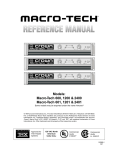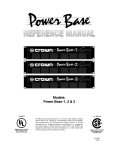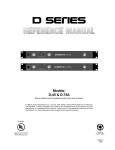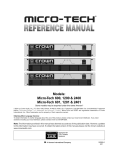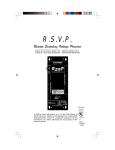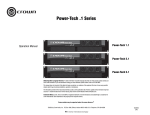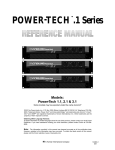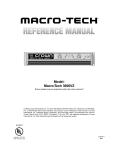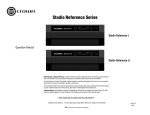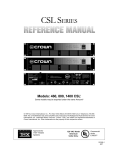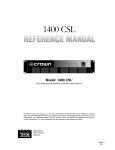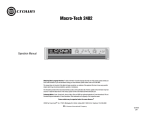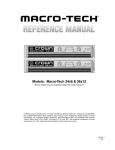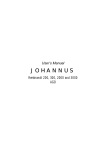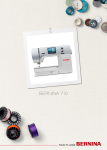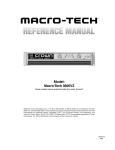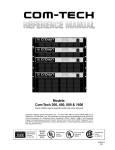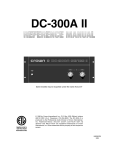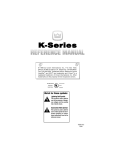Download Crown Micro-Tech MT-1000 Technical information
Transcript
POWER ODEP CH1 CH2 OFF POWER ODEP CH1 CH2 OFF Models: Micro-Tech 600, 1200 & 2400 Micro-Tech 601, 1201 & 2401 Some models may be exported under the name Amcron.® © 1997 by Crown International, Inc., P.O. Box 1000, Elkhart, IN 46515-1000 U.S.A. Telephone: 219-294-8000. Fax: 219-294-8329. Micro-Tech amplifiers are produced by the Professional Audio Division of Crown International, Inc. Trademark Notice: Grounded bridge™ is a trademark and Amcron,® Crown,® Techron,® Micro-Tech,® ODEP ® and TEF ® are registered trademarks of Crown International, Inc. Other trademarks are the property of their respective owners. Approved for THX Theatre Systems (MT-600 & 1200) 120 VAC North American Units Only: ® Commercial Audio E106377 (MT-600 & 1200) ® Commercial Audio LL 32521C (MT-600 & 1200) For Canada ® (MT-2400) 102990-1 7/97 3 YEAR THREE YEAR FULL WARRANTY 3 YEAR WORLDWIDE NORTH AMERICA SUMMARY OF WARRANTY The Crown Audio Division of Crown International, Inc., 1718 West Mishawaka Road, Elkhart, Indiana 46517-4095 U.S.A. warrants to you, the ORIGINAL PURCHASER and ANY SUBSEQUENT OWNER of each NEW Crown1 product, for a period of three (3) years from the date of purchase by the original purchaser (the “warranty period”) that the new Crown product is free of defects in materials and workmanship, and we further warrant the new Crown product regardless of the reason for failure, except as excluded in this Crown Warranty. SUMMARY OF WARRANTY The Crown Audio Division of Crown International, Inc., 1718 West Mishawaka Road, Elkhart, Indiana 46517-4095 U.S.A. warrants to you, the ORIGINAL PURCHASER and ANY SUBSEQUENT OWNER of each NEW Crown product, for a period of three (3) years from the date of purchase by the original purchaser (the “warranty period”) that the new Crown product is free of defects in materials and workmanship. We further warrant the new Crown product regardless of the reason for failure, except as excluded in this Warranty. 1 Note: If your unit bears the name “Amcron,” please substitute it for the name “Crown” in this warranty. ITEMS EXCLUDED FROM THIS CROWN WARRANTY This Crown Warranty is in effect only for failure of a new Crown product which occurred within the Warranty Period. It does not cover any product which has been damaged because of any intentional misuse, accident, negligence, or loss which is covered under any of your insurance contracts. This Crown Warranty also does not extend to the new Crown product if the serial number has been defaced, altered, or removed. ITEMS EXCLUDED FROM THIS CROWN WARRANTY This Crown Warranty is in effect only for failure of a new Crown product which occurred within the Warranty Period. It does not cover any product which has been damaged because of any intentional misuse, accident, negligence, or loss which is covered under any of your insurance contracts. This Crown Warranty also does not extend to the new Crown product if the serial number has been defaced, altered, or removed. WHAT THE WARRANTOR WILL DO We will remedy any defect, regardless of the reason for failure (except as excluded), by repair, replacement, or refund. We may not elect refund unless you agree, or unless we are unable to provide replacement, and repair is not practical or cannot be timely made. If a refund is elected, then you must make the defective or malfunctioning product available to us free and clear of all liens or other encumbrances. The refund will be equal to the actual purchase price, not including interest, insurance, closing costs, and other finance charges less a reasonable depreciation on the product from the date of original purchase. Warranty work can only be performed at our authorized service centers. We will remedy the defect and ship the product from the service center within a reasonable time after receipt of the defective product at our authorized service center. WHAT THE WARRANTOR WILL DO We will remedy any defect, regardless of the reason for failure (except as excluded), by repair, replacement, or refund. We may not elect refund unless you agree, or unless we are unable to provide replacement, and repair is not practical or cannot be timely made. If a refund is elected, then you must make the defective or malfunctioning product available to us free and clear of all liens or other encumbrances. The refund will be equal to the actual purchase price, not including interest, insurance, closing costs, and other finance charges less a reasonable depreciation on the product from the date of original purchase. Warranty work can only be performed at our authorized service centers or at the factory. We will remedy the defect and ship the product from the service center or our factory within a reasonable time after receipt of the defective product at our authorized service center or our factory. All expenses in remedying the defect, including surface shipping costs in the United States, will be borne by us. (You must bear the expense of shipping the product between any foreign country and the port of entry in the United States and all taxes, duties, and other customs fees for such foreign shipments.) HOW TO OBTAIN WARRANTY SERVICE You must notify us of your need for warranty service not later than ninety (90) days after expiration of the warranty period. All components must be shipped in a factory pack. Corrective action will be taken within a reasonable time of the date of receipt of the defective product by our authorized service center. If the repairs made by our authorized service center are not satisfactory, notify our authorized service center immediately. HOW TO OBTAIN WARRANTY SERVICE You must notify us of your need for warranty service not later than ninety (90) days after expiration of the warranty period. All components must be shipped in a factory pack, which, if needed, may be obtained from us free of charge. Corrective action will be taken within a reasonable time of the date of receipt of the defective product by us or our authorized service center. If the repairs made by us or our authorized service center are not satisfactory, notify us or our authorized service center immediately. DISCLAIMER OF CONSEQUENTIAL AND INCIDENTAL DAMAGES YOU ARE NOT ENTITLED TO RECOVER FROM US ANY INCIDENTAL DAMAGES RESULTING FROM ANY DEFECT IN THE NEW CROWN PRODUCT. THIS INCLUDES ANY DAMAGE TO ANOTHER PRODUCT OR PRODUCTS RESULTING FROM SUCH A DEFECT. DISCLAIMER OF CONSEQUENTIAL AND INCIDENTAL DAMAGES YOU ARE NOT ENTITLED TO RECOVER FROM US ANY INCIDENTAL DAMAGES RESULTING FROM ANY DEFECT IN THE NEW CROWN PRODUCT. THIS INCLUDES ANY DAMAGE TO ANOTHER PRODUCT OR PRODUCTS RESULTING FROM SUCH A DEFECT. SOME STATES DO NOT ALLOW THE EXCLUSION OR LIMITATIONS OF INCIDENTAL OR CONSEQUENTIAL DAMAGES, SO THE ABOVE LIMITATION OR EXCLUSION MAY NOT APPLY TO YOU. WARRANTY ALTERATIONS No person has the authority to enlarge, amend, or modify this Crown Warranty. This Crown Warranty is not extended by the length of time which you are deprived of the use of the new Crown product. Repairs and replacement parts provided under the terms of this Crown Warranty shall carry only the unexpired portion of this Crown Warranty. DESIGN CHANGES We reserve the right to change the design of any product from time to time without notice and with no obligation to make corresponding changes in products previously manufactured. LEGAL REMEDIES OF PURCHASER No action to enforce this Crown Warranty shall be commenced later than ninety (90) days after expiration of the warranty period. THIS STATEMENT OF WARRANTY SUPERSEDES ANY OTHERS CONTAINED IN THIS MANUAL FOR CROWN PRODUCTS. 9/90 WARRANTY ALTERATIONS No person has the authority to enlarge, amend, or modify this Crown Warranty. This Crown Warranty is not extended by the length of time which you are deprived of the use of the new Crown product. Repairs and replacement parts provided under the terms of this Crown Warranty shall carry only the unexpired portion of this Crown Warranty. DESIGN CHANGES We reserve the right to change the design of any product from time to time without notice and with no obligation to make corresponding changes in products previously manufactured. LEGAL REMEDIES OF PURCHASER THIS CROWN WARRANTY GIVES YOU SPECIFIC LEGAL RIGHTS, YOU MAY ALSO HAVE OTHER RIGHTS WHICH VARY FROM STATE TO STATE. No action to enforce this Crown Warranty shall be commenced later than ninety (90) days after expiration of the warranty period. THIS STATEMENT OF WARRANTY SUPERSEDES ANY OTHERS CONTAINED IN THIS MANUAL FOR CROWN PRODUCTS. Telephone: 219-294-8200. Facsimile: 219-294-8301 Telephone: 219-294-8200. Facsimile: 219-294-8301 9/90 The information furnished in this manual does not include all of the details of design, production, or variations of the equipment. Nor does it cover every possible situation which may arise during installation, operation or maintenance. If your unit bears the name “Amcron,” please substitute it for the name “Crown” in this manual. If you need special assistance beyond the scope of this manual, please contact our Technical Support Group. Crown Audio Division Technical Support Group Plant 2 SW, 1718 W. Mishawaka Rd., Elkhart, Indiana 46517 U.S.A. Phone: 800-342-6939 (North America, Puerto Rico and Virgin Islands) or 219-294-8200 Fax: 219-294-8301 Fax Back (North America only): 800-294-4094 or 219-293-9200 Fax Back (International): 219-294-8100 Internet: http://www.crownintl.com IMPORTANT THE MICRO-TECH 2400 REQUIRES CLASS 1 OUTPUT WIRING. THE MICRO-TECH 600 & 1200 REQUIRE CLASS 2 OUTPUT WIRING. CAUTION AVIS RISK OF ELECTRIC SHOCK DO NOT OPEN RISQUE DE CHOC ÉLECTRIQUE N’OUVREZ PAS TO PREVENT ELECTRIC SHOCK DO NOT REMOVE TOP OR BOTTOM COVERS. NO USER SERVICEABLE PARTS INSIDE. REFER SERVICING TO QUALIFIED SERVICE PERSONNEL. DISCONNECT POWER CORD BEFORE REMOVING BACK PANEL COVER TO ACCESS GAIN SWITCH. À PRÉVENIR LE CHOC ÉLECTRIQUE N’ENLEVEZ PAS LES COUVERCLES. IL N’Y A PAS DES PARTIES SERVICEABLE À L’INTÉRIEUR. TOUS REPARATIONS DOIT ETRE FAIRE PAR PERSONNEL QUALIFIÉ SEULMENT. DÉBRANCHER LA BORNE AVANT D’ENLEVER LA COVERTURE EN ARRIÈRE. Magnetic Field CAUTION! Do not locate sensitive high-gain equipment such as preamplifiers or tape decks directly above or below the unit. Because this amplifier has a high power density, it has a strong magnetic field which can induce hum into unshielded devices that are located nearby. The field is strongest just above and below the unit. WARNING TO REDUCE THE RISK OF ELECTRIC SHOCK, DO NOT EXPOSE THIS EQUIPMENT TO RAIN OR MOISTURE! If an equipment rack is used, we recommend locating the amplifier(s) in the bottom of the rack and the preamplifier or other sensitive equipment at the top. WATCH FOR THESE SYMBOLS: The lightning bolt triangle is used to alert the user to the risk of electric shock. The exclamation point triangle is used to alert the user to important operating or maintenance instructions. Printed on recycled paper. Micro-Tech 600/1200/2400 Power Amplifiers CONTENTS 1 Welcome .......................................................................... 7 1.1 Unpacking ................................................................. 7 1.2 Features .................................................................... 7 2 Facilities .......................................................................... 8 3 Installation ..................................................................... 10 3.1 Mounting ................................................................. 10 3.2 Cooling .................................................................... 10 3.3 Wiring ...................................................................... 11 3.3.1 Stereo (Two-Channel) Operation .................... 11 3.3.2 Bridge-Mono Operation ................................. 12 3.3.3 Parallel-Mono Operation ................................ 13 3.3.4 Input Connection ........................................... 14 3.3.5 Output Connection ........................................ 16 3.3.6 Additional Load Protection ............................ 18 3.4 AC Mains Power Requirements ................................ 18 4 Operation ....................................................................... 19 4.1 Precautions .............................................................. 19 4.2 Indicators ................................................................. 19 4.3 Protection Systems .................................................. 19 4.3.1 ODEP ............................................................ 19 4.3.2 Ultrasonic and Radio Frequency Protection ... 20 4.3.3 Drive Protection ............................................. 20 4.3.4 Transformer Thermal Protection ..................... 20 4.3.5 Fuses and Circuit Breakers ........................... 20 4.4 Controls ................................................................... 21 4.5 Filter Cleaning .......................................................... 21 5 Technical Information ................................................... 22 5.1 Overview ................................................................. 22 5.2 Circuit Theory .......................................................... 22 5.2.1 Stereo Operation ........................................... 22 5.2.2 Bridge-Mono Operation ................................. 24 5.2.3 Parallel-Mono Operation ................................ 24 6 Specifications ............................................................... 25 7 AC Power Draw and Thermal Dissipation ................... 34 8 Accessories ................................................................... 36 8.1 Cooling Fan Options ................................................ 36 8.2 Input Connectors ..................................................... 36 8.2.1 MT-XLR .......................................................... 36 8.2.2 MT-BB ........................................................... 36 9 Service ........................................................................... 37 9.1 Worldwide Service ................................................... 37 9.2 North American Service ........................................... 37 9.2.1 Service at a North American Service Center .. 37 9.2.2 Factory Service ............................................. 37 Page 4 Micro-Tech 600/1200/2400 Power Amplifiers ILLUSTRATIONS 1.1 2.1 2.2 3.1 3.2 3.3 3.4 3.5 3.6 3.7 3.8 3.9 3.10 3.11 3.12 3.13 3.14 3.15 3.16 4.1 4.2 5.1 6.1 6.2 6.3 6.4 6.5 6.6 6.7 6.8 6.9 6.10 6.11 6.12 6.13 7.1 7.2 7.3 8.1 8.2 Micro-Tech Amplifier .................................................................. 7 Front Facilities ............................................................................ 8 Rear Facilities ............................................................................ 9 Mounting Dimensions .............................................................. 10 Top View of a Rack-Mounted Unit ............................................. 10 Proper Air Flow with a Rack-Mounted Blower ........................... 10 Stereo Wiring ........................................................................... 11 Bridge-Mono Wiring ................................................................. 12 Parallel-Mono Wiring ................................................................ 13 Unbalanced Input Wiring for the Optional MT-XLR ................... 14 Balanced Input Wiring for the Optional MT-XLR ........................ 14 Balanced and Unbalanced Phone Plug Wiring ......................... 14 Subsonic Filter Capacitors ....................................................... 15 Unbalanced RF Filters .............................................................. 15 Balanced RF Filters .................................................................. 15 Wire Size Nomograph .............................................................. 16 Low-Frequency Protection Circuit for Inductive Loads ............. 17 Loudspeaker Fuse Nomograph ............................................... 18 AC Mains Cords and Plugs ...................................................... 18 Indicators ................................................................................. 19 Input Sensitivity and Ground Lift Switches ................................ 21 Circuit Block Diagram .............................................................. 23 Micro-Tech 600 Minimum Power Matrix .................................... 27 Micro-Tech 1200 Minimum Power Matrix .................................. 28 Micro-Tech 2400 Minimum Power Matrix .................................. 28 Micro-Tech 600 Maximum Power Matrix ................................... 29 Micro-Tech 1200 Maximum Power Matrix ................................. 30 Micro-Tech 2400 Maximum Power Matrix ................................. 30 Typical Frequency Response ................................................... 31 Typical Damping Factor ........................................................... 31 Typical Output Impedance ....................................................... 31 Typical Phase Response .......................................................... 32 Typical Crosstalk for the Micro-Tech 600 .................................. 32 Typical Crosstalk for the Micro-Tech 1200 ................................ 33 Typical Crosstalk for the Micro-Tech 2400 ................................ 33 Micro-Tech 600 Power Draw, Current Draw and Thermal Dissipation at Various Duty Cycles ........................................... 34 Micro-Tech 1200 Power Draw, Current Draw and Thermal Dissipation at Various Duty Cycles ........................................... 35 Micro-Tech 2400 Power Draw, Current Draw and Thermal Dissipation at Various Duty Cycles ........................................... 35 MT-XLR .................................................................................... 36 MT-BB ...................................................................................... 36 Page 5 Micro-Tech 600/1200/2400 Power Amplifiers Page 6 Micro-Tech 600/1200/2400 Power Amplifiers POWER ODEP CH1 CH2 OFF Fig. 1.1 Micro-Tech Amplifier 1 Welcome Congratulations on your purchase of a Micro-Tech® professional power amplifier. Crown’s Micro-Tech 600, 1200 and 2400 are the original industry standards for touring amplifiers. Micro-Tech amplifiers are known around the world as a the benchmark for high-density, ultra-pure power in a compact, lightweight package. In addition, each model gives you Crown’s legendary ODEP® protection to keep the show going long after other amplifiers would fail. This manual will help you successfully install and use your new amplifier—we strongly recommend you read all instructions, warnings and cautions. Be sure to read Sections 3.3.2 and 3.3.3 if you plan to use the amplifier in one of its two mono modes. Also for your protection, please send in your warranty registration card today and save your bill of sale since it is your official proof of purchase. put stages combine to provide performance and reliability that surpass all traditional designs. Micro-Tech amplifiers also have an independent high-voltage power supply for each channel. This approach results in extremely low crosstalk and makes it possible to use each channel as a separate amplifier. Here are some more impressive features of your Micro-Tech amplifier: ❏ Patented ODEP (Output Device Emulation Protection) circuitry compensates for overheating and overload to keep the amplifier working long after others would fail. ❏ Crown’s grounded bridge design delivers incredible voltage swings without using stressful output transistor configurations like more traditional amplifiers. This results in significantly lower distortion and superior reliability. ❏ Very low harmonic and intermodulation distortion result in the best dynamic transfer function in the industry. ❏ High damping factor provides superior motion control over low-frequency drivers for clean, accurate low end. 1.1 Unpacking Please unpack and inspect your new amplifier for any damage that may have occurred during transit. If damage is found, notify the transportation company immediately. Only you, the consignee, may initiate a claim for shipping damage. Crown will be happy to cooperate fully as needed. Save the shipping carton as evidence of damage for the shipper’s inspection. Even if the unit arrived in perfect condition, as most do, save all packing materials so you will have them if you ever need to transport the unit. NEVER SHIP THE UNIT WITHOUT THE FACTORY PACK. 1.2 Features Micro-Tech amplifiers use the latest technology and miniaturized design to deliver the highest power and value for their size, weight and price. Crown’s patented ODEP protection circuitry and grounded bridge™ out- ❏ Two mono modes (Bridge-Mono and Parallel-Mono) for driving a wide range of load impedances. ❏ Full protection against shorted outputs, open circuits, DC, mismatched loads, general overheating, highfrequency overloads and internal faults. ❏ Efficient heat sinks and self-contained forced air cooling prevent overheating and prolong component life. ❏ Ground lift switch to isolate chassis and phone jack audio grounds. ❏ Binding post outputs provide easy and versatile output connection. ❏ Internal three-position input sensitivity switch provides settings of 0.775 and 1.4 volts for standard 1 kHz power, and 26 dB voltage gain. ❏ Mounts in a standard 19 inch (48.3 cm) equipment rack (units can also be stacked). ❏ Three year “No-Fault” full warranty completely protects your investment and guarantees its specifications. Page 7 Micro-Tech 600/1200/2400 Power Amplifiers POWER ODEP CH1 A B OFF CH2 C C D Fig. 2.1 Front Facilities 2 Facilities A. Filter Grille E. Power Switch This metal grille supports and protects the dust filter (B). To clean the dust filter, detach the grille by removing the three screws that hold it in place. This rocker switch is used to turn the amplifier on and off. When turned on, the output is muted for approximately four seconds to protect your system from startup transients. (To change the start-up delay time, contact Crown’s Technical Support Group.) B. Dust Filter The dust filter removes large particles from the air drawn by the cooling fan. Check the filter regularly to prevent clogging (see Sections 3.2 and 4.5). C. ODEP Indicators During normal operation of the Output Device Emulation Protection circuitry, these amber indicators glow brightly to show that reserve thermodynamic energy is present. They dim proportionally as energy reserves decrease. In the rare event that energy reserves are depleted, the ODEP indicators turn off and the protection circuitry proportionally limits output drive so the amplifier can safely continue operating even under severe conditions. These indicators also help identify more unusual operating conditions (see Section 4.2). F. Power Cord All units are shipped with an appropriate plug and cord for the required AC voltage (see Figure 3.16). Also, refer to Section 7 for power usage information. G. Stereo/Mono Switch The amplifier’s three operating modes are controlled by this switch. Use Stereo mode for normal two-channel operation, Bridge-Mono mode to drive a single channel with a load impedance of at least 4 ohms, and Parallel-Mono mode to drive a single channel with a load impedance less than 4 ohms. Important: Turn off the amplifier before changing the stereo/mono switch (see Section 3.3). D. Enable Indicator H. Reset Switches (Micro-Tech 2400 only) This indicator lights when the amplifier is turned on, AC power is available and the low-voltage power supply and fan are operational (see Section 4.2). The Micro-Tech 2400 has two push-button reset switches on the back panel that are used to reset the circuit breakers for the high-voltage power supplies. Page 8 Micro-Tech 600/1200/2400 Power Amplifiers BRIDGE-MONO WIRING – PUSH TO RESET CH-2 5 PARALLEL MONO 6 7 4 STEREO F RED TERMINALS ONLY. (CH-1 IS POSITIVE.) CH-1 BRIDGE MONO + CAUTION: TURN OFF AMPLIFIER BEFORE CHANGING THIS SWITCH! G H – GND TIP 12 GAIN RING SLEEVE I J 8 INPUT LIFT 9 2 INPUT GROUND LIFT 11 0 7 3 10 1 6 4 9 2 BALANCED INPUT WIRING 5 8 3 WARNING: TO REDUCE THE RISK OF FIRE OR ELECTRIC SHOCK DO NOT EXPOSE THIS EQUIPMENT TO RAIN OR MOISTURE. CH-1 10 1 INPUT 11 0 (AFFECTS PHONE INPUTS ONLY.) (MONO) GAIN L K J K INTERNATIONAL, INC. ELECTRONIC EQUIPMENT ® UNBALANCED INPUT WIRING 12 + TIP ELKHART, IN 46517 MADE IN U.S.A. SERIAL NUMBER GND SWITCH TO BRIDGE-MONO. 3 OUTPUT ACROSS CLASS 1 OUTPUT WIRING REQUIRED. THIS AMPLIFIER IS EQUIPPED WITH SELECTABLE INPUT SENSITIVITY. REMOVE COVER PLATE (ABOVE) TO ACCESS SENSITIVITY SWITCH. MAXIMUM OUTPUT: 900 WATTS PER CHANNEL INTO 2 OHMS AT 1 KHz WITH NO MORE THAN 0.1% THD. REG. U.S. PAT. OFF. 4,330,809 4,611,180 + OUTPUTS CH-2 MODEL: MICRO-TECH 2400 SERIES AC VOLTS: 120 AMPS: 17 60 Hz 1 TURN AMPLIFIER OFF. 2 SET STEREO/MONO CAUTION: THIS COVER IS NECESSARY FOR EFFICIENT COOLING OF THE AMPLIFIER. REMOVE ONLY TO ACCESS GAIN SWITCH. 0000 PARALLEL-MONO WIRING + 1 TURN AMPLIFIER OFF. 2 SET STEREO/MONO – SWITCH TO PARALLEL-MONO. 3 ADD JUMPER (14 GAGE OR LARGER) ACROSS RED TERMINALS. 4 OUTPUT ACROSS CH-1 TERMINALS ONLY. 000000 SLEEVE M M Fig. 2.2 Rear Facilities I. Cover Plate This cover plate is removed when changing the amplifier’s input sensitivity (see Section 4.4) or installing an MT-XLR or MT-BB accessory (see Section 8.2). ❑ Input Sensitivity Switch The three-position input sensitivity switch is located inside the amplifier behind the cover plate (I). Settings include 0.775 volts and 1.4 volts for standard 1 kHz power, and 26 dB gain (see Section 4.4). J. Level Controls These back panel level controls are used to set the amplifier’s output levels (see Section 4.4). Be sure to turn down the channel 2 level control (fully counterclockwise) when operating in Bridge-Mono mode. K. Balanced Phone Jack Inputs A balanced ¼-inch phone jack input is provided for each channel. They may be wired for balanced (tip, ring and sleeve) or unbalanced (tip and sleeve) operation (refer to Section 3.3.4). XLR and barrier block input connectors are available with the MT-XLR and MT-BB accessories (see Section 8.2). Caution: Do not use the channel 2 input in either mono mode. L. Ground Lift Switch This switch is used to isolate the phone jack signal grounds from the AC power (chassis) ground. Moving the switch to the “lift” position helps prevent the hum associated with ground loops (see Section 4.4). M. Output Jacks A pair of versatile binding posts is provided for output connection to each channel. Loudspeakers can be easily connected using banana plugs, spade lugs or bare wire (European models do not accept banana plugs). See Section 3.3. Page 9 Micro-Tech 600/1200/2400 Power Amplifiers 3 Installation 3.1 Mounting Micro-Tech amplifiers are designed for standard 19inch (48.3 cm) rack mounting or stacking without a cabinet. In a rack, it is best to mount units directly on top of each other. This provides the most efficient air flow and support. If the rack will be transported, we recommend that you provide support for the amplifier’s back panel or secure it to the rack to help support the unit’s weight. POWER ODEP CH1 CH2 3.5 in 8.9 cm OFF 19 in 48.3 cm SIDE VIEW 16 in 40.6 cm Fig. 3.1 Mounting Dimensions 3.2 Cooling Micro-Tech amplifiers include an internal fan that runs when the unit is turned on. Before mounting your amplifier, you should familiarize yourself with its cooling requirements. Here are some tips to help keep your amplifier cool. First, never block the amplifier’s front or side air vents. If the amplifier is rack-mounted, its sides should be at least 2 inches (5 cm) away from the cabinet (see Figure 3.2). Also, open spaces in the rack should be covered to prevent heated air from the side exhaust vents from being drawn into the front air intake. You will know when your Micro-Tech amplifier has sufficient cooling because its ODEP indicators will be brightly lit. If the amplifier’s ODEP indicators dim or turn off, overly demanding conditions are forcing it to protect itself from overheating. If you experience a cooling problem, you should consider several factors that may be contributing to the problem, including load impedance, air flow and ambient air temperature. Low-impedance loads generate more heat than higher impedance loads. To avoid impedance-related cooling problems, connect loads to each channel with a total impedance of at least 2 ohms in Stereo, 4 ohms in Bridge-Mono, and 1 ohm in Parallel-Mono mode (see Section 3.3 for wiring instructions). If your loads are reasonable and you still have a cooling problem, check for shorts in the loudspeaker cables, and look for problems with air flow or ambient air temperature. Air flow restrictions are the most common cause of inadequate cooling. They may result from improper mounting, bundles of power cords, clogged dust filters and closed rack doors. Mount the amplifier to allow sufficient air flow into the front intake, out the side exhaust vents, and out the back of the rack. Move air flow restrictions like bundled power cords out of the way. Use the procedure in Section 4.5 to clean the air filters. Leave rack doors open, remove them, or install a grille. If you install a grille, we recommend using a wire grille because perforated panels restrict air flow by at least 40%. If your ODEP indicators still dim under demanding conditions, you may want to install supplemental cooling like a rack-mounted blower or an air conditioner. A “squirrel cage” blower can be installed at the bottom of AIR FLOW BLOWER (OPTION 2) FRONT OF RACK 17 in DOOR IMPORTANT: Be sure the back of the amplifier is supported. AIR FLOW EQUIPMENT RACK (SIDE VIEW) AIR FLOW AMPLIFIER (TOP VIEW) 16 in 2 in MIN. RACK CABINET AIR FLOW BLOWER (OPTION 1) AIR FLOW Fig. 3.2 Top View of a Rack-Mounted Unit Page 10 Fig. 3.3 Proper Air Flow with a Rack-Mounted Blower Micro-Tech 600/1200/2400 Power Amplifiers the rack so it blows outside air into the space between the door and the front of the amplifiers. This will pressurize the “chimney” behind the door (Figure 3.3, Option 1). The blower should not blow air into or take air out of the space behind the amplifiers. For racks without a front door, you can evacuate the rack by mounting the blower at the top of the rack so air blows out the back (Figure 3.3, Option 2). You can estimate a rack’s required air flow by adding each unit’s maximum air flow rating. Each Micro-Tech 600 and 1200 can move 35 cubic feet (1 cubic meter) of air per minute, and each Micro-Tech 2400 can move 45 cubic feet (1.3 cubic meters) of air per minute. So if you put one of each in a rack, you would need 115 cubic feet (3.2 cubic meters) of air flow through the rack per minute under worst-case conditions (35 cubic feet + 35 cubic feet + 45 cubic feet = 115 cubic feet). Another cooling problem to consider is high ambient air temperature. If the ambient air temperature is extremely high, ODEP may reduce the output to protect the amplifier even when it is receiving the maximum recommended air flow. Under these unusual conditions, it may be necessary to use air conditioning for supplemental cooling. Air conditioning is rarely a necessity because internal fans and rack-mounted blowers almost always provide enough air flow for the most extreme conditions. Still, air conditioning helps reduce the ambient temperature of the air flowing through the rack. If you plan to use air conditioning, refer to Section 7 for information on calculating the hourly thermal dissipation of your system. 3.3 Wiring The following section describes common ways to install your amplifier in a sound system. The input and output terminals are located on the back panel. Please use care when making connections, selecting signal sources and controlling the output level. The load you save may be your own! Crown assumes no liability for damaged loads resulting from careless amplifier use or deliberate overpowering. CAUTION: When making or changing connections, always disconnect the AC power and turn the level controls off (fully counterclockwise). This is very important because it reduces the chance of loud blasts that can cause loudspeaker damage. Micro-Tech amplifiers may be operated in one of three modes (Stereo, Bridge-Mono and Parallel-Mono) by switching the stereo/mono switch on the back panel. There are VERY IMPORTANT wiring differences among these three modes which are discussed next. 3.3.1 Stereo (Two-Channel) Operation In Stereo mode, installation is very intuitive: input channel 1 feeds output channel 1, and input channel 2 feeds output channel 2. To put the amplifier into Stereo mode, first turn it off, then slide the stereo/mono switch to the center position, and properly connect the output wiring as shown in Figure 3.4. Each channel has a pair of binding posts for easy loudspeaker cable connection. Observe correct polarity, and be very careful not to short the two channels together. STEREO MODE CHANNEL 2 CHANNEL 1 – CHANNEL 2 + MIXER LOUDSPEAKERS + – CH-2 CH-1 STEREO PARALLEL MONO BRIDGE MONO CHANNEL 1 MICRO-TECH AMPLIFIER STEREO PARALLEL MONO BRIDGE MONO CH.2 LEVEL CONTROL CH.1 GROUND LEVEL LIFT SWITCH CONTROL CAUTION: TURN OFF AMPLIFIER BEFORE CHANGING THIS SWITCH. Fig. 3.4 Stereo Wiring Page 11 Micro-Tech 600/1200/2400 Power Amplifiers CAUTION: In Stereo mode, never tie the amplifier’s outputs directly together, and never parallel them with the output of another amplifier. Such connections do not increase the output power and may activate the protection circuitry to prevent overheating. USE THE CHANNEL 2 INPUT or signal quality will be greatly degraded. Also, turn down the channel 2 level control (fully counterclockwise). Note: The channel 2 input and level control are not defeated in Bridge-Mono mode. Any signal feeding channel 2 will work against the channel 1 signal, and usually results in distortion and inefficient operation. 3.3.2 Bridge-Mono Operation Bridge-Mono mode is used to drive loads with a total impedance of at least 4 ohms (see Section 3.3.3 if the load is less than 4 ohms). Wiring for Bridge-Mono mode is very different from the other modes and requires special attention. First, turn off the amplifier. Then select Bridge-Mono mode by sliding the stereo/mono switch to the right (as you face the back panel). Both outputs receive the channel 1 input signal, but channel 2 is inverted so it can be bridged with channel 1. DO NOT Connect the load across the two red (+) binding posts as shown in Figure 3.5. The positive (+) lead from the loudspeaker connects to the red (+) channel 1 binding post, and the negative (–) or ground lead from the loudspeaker connects to the red (+) channel 2 binding post. Do not connect the black (–) binding posts. Also, the load must be balanced so neither lead is connected to ground. BRIDGE-MONO MODE ONLY USE THE CHANNEL 1 INPUT – + DO NOT USE BLACK TERMINALS DO NOT USE MIXER CH-2 CH-1 STEREO PARALLEL MONO BRIDGE MONO MICRO-TECH AMPLIFIER TURN CHANNEL 2 OFF (FULLY CCW) IN THIS MODE. STEREO PARALLEL MONO BRIDGE MONO CAUTION: TURN OFF AMPLIFIER BEFORE CHANGING THIS SWITCH. Fig. 3.5 Bridge-Mono Wiring Page 12 LOUDSPEAKER Micro-Tech 600/1200/2400 Power Amplifiers CAUTION: Only connect balanced equipment (meters, switches, etc.) to the Bridge-Mono output. Both sides of the line must be isolated from the input grounds or oscillations may occur. 3.3.3 Parallel-Mono Operation Parallel-Mono mode is used to drive loads with a total impedance of less than 4 ohms (see Section 3.3.2 if the load is 4 ohms or more). Installing the amplifier in Parallel-Mono mode is very different from the other modes and requires special attention. To select Parallel-Mono mode, turn off the amplifier and slide the stereo/mono switch to the left (as you face the back panel). Connect the input signal to channel 1 only. The channel 2 input and level control are bypassed in this mode, and should not be used. Connect the load to the channel 1 output as shown in Figure 3.6. The positive loudspeaker lead (+) connects to the red (+) channel 1 binding post and the negative (–) or ground lead from the loudspeaker connects to the black (–) channel 1 binding post. Finally, install a jumper wire of at least 14 gauge between the red (+) binding posts of both channels 1 and 2. CAUTION: When wired for Parallel-Mono mode, do not operate the amplifier in Stereo or Bridge-Mono mode until the output wiring is reconfigured. Failure to do so will result in inefficient operation, high distortion and excessive heating. PARALLEL-MONO MODE ONLY USE THE CHANNEL 1 INPUT CHANNEL 2 IS NOT USED IN THIS MODE. MIXER CH-2 ADD A 14 GAUGE (OR LARGER) JUMPER BETWEEN THE RED CHANNEL 1 AND CHANNEL 2 BINDING POSTS. + – LOUDSPEAKER CH-1 STEREO PARALLEL MONO BRIDGE MONO MICRO-TECH AMPLIFIER STEREO PARALLEL MONO BRIDGE MONO CAUTION: TURN OFF AMPLIFIER BEFORE CHANGING THIS SWITCH. Fig. 3.6 Parallel-Mono Wiring Page 13 Micro-Tech 600/1200/2400 Power Amplifiers 3.3.4 Input Connection The balanced phone jack inputs have a nominal impedance of 20 K ohms (10 K ohms with unbalanced wiring) and will accept the line-level output of most devices. Three-pin female XLR connectors are also available on the optional MT-XLR accessory and balanced barrier block connectors are available on the optional MT-BB accessory (see Section 8.2). Correct input wiring will depend on two factors: (1) whether the input signals are balanced or unbalanced, and (2) whether the signal source floats or has a ground reference. Figures 3.7 and 3.8 provide examples of recommended connection techniques for each type of signal source. The optional MT-XLR connector is shown. – + Note: If two or more channels with the same input ground reference are driven from the same INPUT floating source, connect Floating only one shield to the source chassis. source Output – + 3 Grounded source 3 Grounded source 1 2 Shield is not connected at this end + 3-wire grounded line cord (or other ground connection) Twin-lead shielded cable – + INPUT 3 1 2 + 2-wire line cord (or battery power) – + 3 INPUT Grounded source 1 2 Input ground terminal not used + Single-conductor coax or twisted pair INPUT Shield connected to both negative (–) and ground input terminals Floating source Output – + Fig. 3.8 Balanced Input Wiring for the Optional MT-XLR The amplifier’s built-in 1¦4-inch input phone connectors can be wired similarly for balanced or unbalanced, floating or ground-referenced sources. The phone connectors have a standard tip-ring-sleeve (TRS) configuration: the tip is positive (+), ring is negative (–) and sleeve is ground (see Figure 3.9). Wiring for different sources follows the XLR wiring guidelines shown in Figures 3.7 and 3.8. Please follow the input wiring instructions in Section 3.3.2 and 3.3.3 if the amplifier will be used in either Bridge-Mono or Parallel-Mono mode. Remember, do not use the channel 2 input in either mono mode. + – BALANCED SHIELD + 3-wire grounded line cord (or other ground connection) UNBALANCED SHIELD Fig. 3.7 Unbalanced Input Wiring for the Optional MT-XLR Page 14 2 Shield not connected at this end When either of the input connector accessories is installed, the unused input connectors can be used as “daisy chain” outputs to feed the input signal from one amplifier to another. – + Output 1 2 + 2-wire line cord (or battery power) Output INPUT Shield connected to ground terminal Floating source Output 1 – + 3-wire grounded line cord (or other ground connection) 3 INPUT 2 2-wire line cord (or battery power) Output – + 3 1 Fig. 3.9 Balanced and Unbalanced Phone Plug Wiring Micro-Tech 600/1200/2400 Power Amplifiers SOLVING INPUT PROBLEMS Sometimes large subsonic (subaudible) frequencies are present in the input signal. These can damage loudspeakers by overloading or overheating them. To attenuate such frequencies, place a capacitor in series with the input signal line. The graph in Figure 3.10 shows some possible capacitor values and how they affect frequency response. Use only low-leakage paper, mylar or tantalum capacitors. 910 Ω + A + .003 µf Balanced In – – 910 Ω 1.8 mH + B Balanced In + .015 µf – Balanced Out – 1.8 mH 2.5 mH + C dB Balanced Out Balanced In + .018 µf – 0 Balanced Out – 2.5 mH –5 0.47 Film 1.8 mH + –10 1 Hz µf 1 kHz 10 kHz Frequency Fig. 3.10 Subsonic Filter Capacitors Another problem to avoid is the presence of large levels of radio frequencies or RF in the input signal. Although high RF levels may not pose a threat to the amplifier, they can burn out tweeters or other loads that are sensitive to high frequencies. Extremely high RF levels may also cause the amplifier to prematurely activate its protection circuitry. RF can be introduced into an input signal by local radio stations or the bias signal of many tape recorders. To prevent RF problems, install appropriate low-pass filters on the inputs. Examples are shown below for unbalanced wiring: 1.8 K ohm Source .003 µf To Amp dB 0 GND 6 dB/octave A 3.9 mH R 600 ohm Source .015 µf To Amp A 12 dB/octave –10 B GND C B 5 mH R 600 ohm Source .018 µf –20 To Amp GND C 4 kHz Note: A low source impedance (R) can be increased to 600 ohms with an appropriate resistor. + .015 µf Balanced Out – 0.47 Film 1.8 mH 0.0 100 Hz Balanced In – 47 µf f 10 Hz 0.1 2µ 0.2 f 0.4 1.0 µf –15 7µ D 10 kHz 40 kHz 100 kHz Frequency Fig. 3.11 Unbalanced RF Filters For balanced input wiring, use one of the examples in Figure 3.12. Filters A, B and C correspond to the unbalanced filters above. Filter D also incorporates the subsonic filter described previously. Fig. 3.12 Balanced RF Filters usually cause hum in the output. A common source of ground loop problems is the placement of input cables parallel to power cables or near power transformers. The magnetic field that surrounds these conductors can induce the 50 or 60 Hz alternating current into your input cables. To prevent this type of ground loop, it is always a good idea to locate input cables away from power cables and power transformers. We also recommend using shielded or twisted pair wire. With loose wires, use tie-wraps to bundle together each pair of input wires. This helps reduce magnetically-induced current by minimizing the cross-sectional area between Input Wiring Tips 1. Use only shielded cable. Cables with higher density shields are better. Spiral wrapped shield is not recommended. 2. When using unbalanced lines, keep the cables as short as possible. Avoid cable lengths greater than 10 feet (3 meters). 3. Do not run signal cables together with high-level wiring such as loudspeaker wires or AC cords. This reduces the chance of hum or noise being induced into the input cables. 4. Turn off the entire system before changing connections. Turn down the level controls (fully counterclockwise) before powering the system back up. Crown is not liable for damage incurred when any transducer or component is overdriven. ound loops Another problem to avoid is gr ground loops. These are undesired currents that flow in a grounded system and Page 15 Micro-Tech 600/1200/2400 Power Amplifiers conductors that could bisect the magnetic field. Ground loops will also occur when the input and output grounds are tied together. DO NOT CONNECT THE INPUT AND OUTPUT GROUNDS TOGETHER. Tying the input and output grounds together can also cause feedback oscillation from the load current flowing in the loop. To avoid this problem use proper grounding, isolate the inputs, and isolate other common AC devices. If necessary, the input phone jack grounds can be isolated from the AC mains (chassis) ground with the ground lift switch located on the back panel of the amplifier (see Figure 2.2 and Section 4.4). 3.3.5 Output Connection Consider the power-handling capacity of your load before connecting it to the amplifier. Crown is not liable for damage incurred at any time due to any load being overpowered. The use of loudspeaker protection fuses is highly recommended (see Section 3.3.6). Also, please pay close attention to the precautions in Section 4.1. excellent damping factor can easily be negated by using insufficient loudspeaker cables. Use the nomograph and the procedure that follow to find the recommended American Wire Gauge (AWG) or resistance per 1000 feet of wire for your system. .0002 .0002 RS Source Resistance (Ohms) .0004 .0006 .001 RL RS Damping Factor .002 20,000 .004 10,000 .006 .01 5,000 RL Load Resistance (Ohms) 40 .02 Copper Wire 2,000 1,000 8000 .04 5000 500 30 .06 Ohms/1000 Feet (305 Meters) .1 200 100 .2 Two Conductor Cable 20 50 Use Good Connectors .4 .6 1. To prevent possible short circuits, insulate exposed loudspeaker cable connectors. 2. Do not use connectors that might accidentally tie conductors together when making or breaking connections (for example, a standard three-wire stereo phone plug). 15 20 1 10 5 2 10 1 0.3 2 0.6 5 1.5 10 3.1 20 6.1 15.3 50 100 1000 500 100 #28 #26 50 #24 30.5 200 61.0 500 152.5 1000 305.0 2000 610.0 5000 1525 2 8 Feet Meters 4. Avoid using connectors with low currentcarrying capacity. 7 10 20 4 40 2 1.5 #18 #16 #14 #10 1 #8 #6 .5 #4 #2 .1 .05 5 .01 3 Example Shown: Load Resistance = 8 ohms Desired Damping Factor = 500 Source Resistance = 0.016 ohms Cable Length = 10 feet (3.1 meters) Recommended Wire: #8 AWG or equivalent wire with 1.75 ohms or less resistance per 1000 feet (305 meters). HOW TO DETERMINE APPROPRIATE WIRE GAUGE 1 Page 16 5 6 5. Do not use connectors that have any tendency to short. It is important to use loudspeaker cables with sufficient gauge (thickness) for the length being used. The resistance introduced by inadequate cables will reduce both the output power and the motion control of the loudspeakers. The latter problem occurs because the damping factor decreases as cable resistance increases. This is very important because the amplifier’s #20 10 1 6 3. Never use connectors that can be plugged into AC power receptacles. #22 #12 9 4 AWG (American Wire Gauge) 0.9 0.8 0.7 0.6 0.5 Fig. 3.13 Wire Size Nomograph #0 #00 #0000 Micro-Tech 600/1200/2400 Power Amplifiers 1. Note the load resistance of the loudspeakers connected to each channel of the amplifier. Mark this value on the “Load Resistance” line of the nomograph. 2. Select an acceptable damping factor and mark it on the “Damping Factor” line. Your amplifier can provide an excellent damping factor of 1,000 from 10 to 400 Hz in Stereo mode with an 8 ohm load. In contrast, typical damping factors are 50 or lower at these frequencies. Higher damping factors yield lower distortion and greater motion control over the loudspeakers. A common damping factor for commercial applications is between 50 and 100. Higher damping factors may be desirable for live sound, but long cable lengths often limit the highest damping factor that can be achieved practically. (Under these circumstances, Crown’s IQ System is often used so amplifiers can be easily monitored and controlled when they are located very near the loudspeakers.) In recording studios and home hi-fi, a damping factor of 500 or more is very desirable. 3. Draw a line through the two points with a pencil, and continue until it intersects the “Source Resistance” line. 4. On the “Two Conductor Cable” line, mark the length of the cable run. 5. Draw a pencil line from the mark on the “Source Resistance” line through the mark on the “Two Conductor Cable” line and intersect the “Copper Wire” line. 6. The required wire gauge for the selected wire length and damping factor is the value on the right-hand scale of the “Copper Wire” line. For metric wire sizes, find the recommended resistance in ohms per 305 meters (1000 feet) and use this information to reference the correct wire size. Note: Wire size increases as the AWG gets smaller. 7. If the size of the cable exceeds what you want to use, (1) find a way to use shorter cables, like using the IQ System, (2) settle for a lower damping factor, or (3) use more than one cable for each line. Options 1 and 2 will require the substitution of new values for cable length or damping factor in the nomograph. For option 3, doubling the number of conductors of equal thickness will reduce the resistance in ohms per 1000 feet (305 meters) by half. When using AWG standards, you can estimate the effective wire gauge by subtracting 3 from the given wire gauge every time the number of conductors of equal gauge is doubled. So, if #10 wire is too large, two #13 wires can be substituted, or four #16 wires can be used for the same effect. SOLVING OUTPUT PROBLEMS High-frequency oscillations can cause your amplifier to prematurely activate its protection circuitry. The effects of this problem are similar to the effects of the RF problems described in Section 3.3.4. To prevent high-frequency oscillations, follow these guidelines: 1. When using long cable runs, or when different amplifiers share a common cable tray or jacket, use tie-wraps to bundle individual conductors so the wires for each loudspeaker are kept close together. Do not bundle wires from different amplifiers. This reduces the chance of conductors acting like antennas that transmit or receive the high frequencies that can cause oscillations. 2. Avoid using shielded loudspeaker cable. 3. Never tie together input and output grounds. 4. Never tie together different amplifier outputs. 5. Keep output cables separated from input cables. 6. Install an RF filter in series with each input (see Section 3.3.4). 7. Install input wiring according to the instructions in Section 3.3.4. Another problem to avoid is the presence of large subsonic currents when primarily inductive loads are used. Examples of inductive loads are 70-volt step-up transformers and electrostatic loudspeakers. Inductive loads can act like a short circuit at low frequencies. This can cause the amplifier to produce large low-frequency currents and activate its protection circuitry. Always take the precaution of installing a subsonic filter in series with each of the amplifier’s inputs when inductive loads are used. A three-pole, 18 dB per octave filter with a –3 dB frequency of 50 Hz is recommended (some applications may benefit from an even higher –3 dB frequency). See Section 3.3.4 for some examples. Another way to protect inductive loads from large lowfrequency currents and to prevent the amplifier from prematurely activating its protective systems is to parallel a 590 to 708 mF nonpolarized motor start capacitor and a 4-ohm, 20-watt resistor in series with the amplifier’s output and the positive (+) lead of the transformer. This circuit is shown in Figure 3.14. It uses components that are available from most electrical supply stores. 4-ohm, 20-watt Resistor + 590 to 708 µf Capacitor 120 VAC, N.P. + From Amplifier Output Inductive Load – – Fig. 3.14 Low-Frequency Protection Circuit for Inductive Loads Page 17 Micro-Tech 600/1200/2400 Power Amplifiers 3.3.6 Additional Load Protection Micro-Tech amplifiers can deliver very high power levels, so it’s a good idea to add some protection if its not already built into your loudspeakers. Loudpseakers are subject to thermal damage from sustained overpowering and mechanical damage from large transient voltages. In both cases, fuses may be used to protect your loudspeakers. Thermal protection and voltage protection require different types of fuses. Slow-blow fuses are used to prevent thermal damage because they respond to thermal conditions like a loudspeaker. High-speed instrument fuses like the Littlefuse 361000 series are used to protect loudspeakers from transient voltages. The nomograph in Figure 3.15 can be used to select the correct fuse for thermal or voltage protection. There are two common ways to install the fuses. One approach is to put a single fuse in series with each output. This is easy because there is only one fuse per channel to install. But if the fuse blows, power is removed from all of the connected loads. A better approach is to fuse each driver independently. This allows you to apply the most appropriate protection for the type of driver being used. In general, lowfrequency drivers (woofers) are the most susceptible to thermal damage and high-frequency drivers (tweeters) are usually damaged by large transient voltages. This means that your loudspeakers will tend to have better protection when the woofers are protected by slow-blow fuses and high-frequency drivers are protected by high-speed instrument fuses. 3.4 AC Mains Power Requirements All Micro-Tech amplifiers are shipped with an appropriate line cord and plug. The standard cord and plug for each model are listed by country (or region) in Figure 3.16. When possible, use a power receptacle on a dedicated circuit, and always make sure it will provide the right voltage with sufficient current. We do not recommend operating your amplifier with voltages greater than 10% above or below the unit’s rated voltage. For example, an amplifier rated for 120 VAC operaton should not exceed 132 VAC. See Section 7 for power requirements under a variety of conditions. 1.0 1.2 Country or Region 1.4 Micro-Tech 600 Cord 1.6 Australia, New Zealand 20 2 2000 10 1500 8 3 1000 800 6 600 5 5 300 3 200 6 Example: Impedance = 8 ohms. Peak Power = 75 W 7 150 2 100 80 1.5 60 8 Answer: Fuse = 1.5 A 9 1 40 .8 10 30 .6 12 20 .5 15 20 25 30 .3 .2 .15 LOUDSPEAKER RATING 16 .4 FUSE (amps) LOUDSPEAKER IMPEDANCE (ohms) 14 10 8 6 4 3 2 .1 .08 1.5 1 40 Fig. 3.15 Loudspeaker Fuse Nomograph Page 18 (Typically 4 times the continuous average power) 400 4 PEAK MUSIC POWER (watts) 4 Cord Plug Micro-Tech 2400 Cord Plug 1.5 mm2 AS 3112 1.5 mm2 AS 3112 1.5 mm2 AS 3112 10 A 10 A 15 A Argentina, Austria, China, 1.5 mm2 CEE 7/7 1.5 mm2 CEE 7/7 1.5 mm2 CEE 7/7 Denmark, Finland, France, Germany, Greece, Holland, Indonesia, Italy, Korea, Malaysia, Portugal, Spain, Sweden, Switzerland, Turkey 3000 15 2.5 Plug Micro-Tech 1200 Brazil, Guam, Hong Kong, 14/3 SJT NEMA 14/3 SJT NEMA 5-15P 5-15P Jamaica, Japan, Peru, Phillipines, Singapore, Tahiti, Taiwan, Thailand, Venezuela 12/3 SO NEMA 5-15P Central America, North America 14/3 SJT NEMA 14/3 SJT NEMA 5-15P 5-15P 12/3 SO NEMA 5-20P India, South Africa 1.5 mm2 1.5 mm2 BS 546 Ireland, Norway, United Kingdom, United Arab Emirates 1.5 mm2 BS 1363 1.5 mm2 BS 1363 1.5 mm2 BS 1363 BS 546 1.5 mm2 BS 546 Fig. 3.16 AC Mains Cords and Plugs All specifications in this manual were measured using 120 VAC, 60 Hz power mains unless otherwise noted. Specifications are derived using a mains voltage that is accurate to within 0.5% with THD less than 1.0% under all testing conditions. Performance variations can occur at other AC mains voltages and line frequencies. In addition, line regulation problems will directly affect the output power available from the amplifier. Micro-Tech 600/1200/2400 Power Amplifiers 4 Operation POWER ODEP 4.1 Precautions Although your amplifier is protected from internal and external faults, you should still take the following precautions for optimum perfromance and safety: 1. Improper wiring for the Stereo, Bridge-Mono and Parallel-Mono modes can result in serious operating difficulties (see Section 3.3). 2. WARNING: Do not change the position of the stereo/mono switch unless the amplifier is first turned off. 3. CAUTION: In Parallel-Mono mode, a jumper is used between the red (+) channel 1 and 2 red output binding posts. Remove this jumper for Bridge-Mono and Stereo modes, or high distortion and excessive heating will occur. Also, check the stereo/mono switch for proper setting. 4. Turn off the amplifier and unplug it from the AC mains before removing the back panel cover plate or before removing and cleaning the dust filter. 5. Use care when making connections, selecting signal sources and controlling the output level. The load you save may be your own! 6. Do not short the ground lead of an output cable to the input signal ground. This will form a ground loop and may cause oscillations. 7. Operate the amplifier from AC mains of not more than 10% above or below the selected line voltage and only at the specified line frequency. 8. Never connect the output to a power supply output, battery or power main. Such connections may result in electrical shock. 9. Tampering with the circuitry by unqualified personnel or making unauthorized circuit changes may be hazardous and invalidates all agency listings. Remember: Crown is not liable for damage that results from overdriving other system components. 4.2 Indicators The amber enable indicator is provided to show that the amplifier has been turned on (or enabled), and its low-voltage power supply and forced-air cooling system are working. It does not indicate the status of the high-voltage power supplies. For example, the enable indicator will remain lit during unusual conditions that would cause the amplifier’s protection systems to tem- CH1 CH2 OFF Fig. 4.1 Indicators porarily remove power from a high-voltage power supply (see Section 4.3). The amber ODEP indicators confirm the normal operation of Crown’s patented Output Device Emulation Protection circuitry. During normal operation, they glow brightly to show the presence of reserve thermodynamic energy. They dim proportionally as the energy reserve decreases. In the rare event that there is no reserve, the indicators turn off and ODEP proportionally limits the drive level of the output stages so the amplifier can continue safe operation even when conditions are severe. (For a more detailed description of ODEP, see Section 4.3.1.) The ODEP indicators also turn off if the amplifier loses AC power, the power switch is turned off, or the lowvoltage power supply fuse blows. The ODEP indicator for the affected channel will turn off if a high-voltage power supply fuse or breaker blows, or if the channel activates transformer thermal protection. Conditions that activate “drive protection” do not affect the ODEP indicators (see Section 4.3.3). 4.3 Protection Systems Micro-Tech amplifiers have extensive protection systems including ODEP, ultrasonic/RF protection, drive protection, and power supply fuses or breakers. 4.3.1 ODEP Crown invented ODEP to solve two long-standing problems in amplifier design: to prevent amplifier shutdown during demanding operation, and to increase the efficiency of the output circuitry. To do this, Crown established a rigorous program to measure the safe operating area (SOA) of each output transistor before installing it in an amplifier. Next, Crown designed intelligent circuitry to simulate the instantaneous operating conditions of those output transistors. Its name describes what it does: Output Device Emulation Protection or ODEP. In addition to simulating output transistor operating conditions, it compares their operation to their known SOA. If ODEP sees that more Page 19 Micro-Tech 600/1200/2400 Power Amplifiers power is needed from the output devices than they can deliver under the present conditions, ODEP immediately limits the drive level until it falls within the SOA. Limiting is proportional and kept to an absolute minimum—only what is required to prevent damage. Under normal conditions, no limiting is required and ODEP is transparent to the audio signal. This level of protection enables Crown to increase output efficiency to never-before-achieved levels while greatly increasing reliability. As described previously, ODEP operation is monitored by the front panel ODEP indicators. They show whether the amplifier is functioning correctly or if ODEP is limiting the drive level. With ODEP you get maximum power with maximum protection so the show goes on. 4.3.2 Ultrasonic and Radio Frequency Protection Micro-Tech amplifiers have a controlled slew rate. This means that their design limits the frequencies they can reproduce. At the same time, the amplifier’s controlled slew rate has no effect on its audio performance because limiting occurs well above 20 kHz. This approach protects the amplifier from radio frequencies, and also protects some sensitive loads (like tweeters). In the real world, an amplifier’s slew rate only needs to be large enough to deliver the maximum voltage at the highest required frequency—higher slew rates actually allow the reproduction of undesirable frequencies. 4.3.4 Transformer Thermal Protection All Micro-Tech amplifiers have transformer thermal protection. The amplifier’s transformer thermal protection circuitry is activated in very unusual circumstances where the unit’s transformer temperature rises to unsafe levels. Under these abnormal conditions, the amplifier will remove power from the affected channel’s high-voltage power supply which puts the channel in drive protection mode. The amplifier channel will return to normal operation after its transformer cools to a safe temperature. It is extremely unlikely that you will ever see a Micro-Tech amplifier activate transformer thermal protection as long as it is operated within rated conditions (see Section 6). One reason is that ODEP keeps the amplifier working under very severe conditions. Even so, higher than rated output levels, excessively lowimpedance loads and unreasonably high input signals can generate more heat in the transformer than in the output devices. These conditions can overheat a transformer and activate its protection system. Micro-Tech amplifiers are designed to keep working under conditions where other amplifiers would fail. But even when a Micro-Tech’s limits are exceeded, it will still protect itself—and your investment—from damage. 4.3.3 Drive Protection The drive protection system temporarily removes drive from the output stages to protect the amplifier and its load(s). Drive protection can be activated in two situations. First, if dangerous subsonic frequencies or direct current (DC) is detected in the amplifier’s output, the unit will activate its DC/low-frequency protection circuitry which puts the affected channel in drive protection mode. This protects the load(s) and prevents oscillation. The amplifier resumes normal operation when it no longer detects dangerous output. Although it is extremely unlikely that you will ever activate the amplifier’s DC/low-frequency protection system, improper source materials like subsonic square waves or a severely clipped signal can activate this system. 4.3.5 Fuses and Circuit Breakers 120 VAC, 60 Hz models and all Micro-Tech 2400s have an internal fuse that protects the low-voltage supply and cooling fan. Micro-Tech 600 and 1200 high-voltage supplies are protected by internal fuses, while Micro-Tech 2400 high-voltage supplies are protected by circuit breakers. With rated loads and output levels, the fuses (or circuit breakers) should only shut down the amplifier in the rare instance of a catastrophic failure. ODEP protection keeps the amplifier operational under most other severe conditions. The fuses (or circuit breakers) can also shut down the amplifier in cases where extremely low-impedance loads and high output levels result in current draw that exceeds their rating. Again, this should only be possible when operating outside rated conditions like when the amplifier is used to drive a 1 ohm load in Stereo mode, or when an input signal is clipped severely. The amplifier’s fault protection system puts the affected channel into drive protection mode in rare situations where heavy common-mode current is detected in its output. The amplifier should never output heavy common-mode current unless its circuitry is damaged. Activating drive protection helps prevent further damage. Micro-Tech amplifiers do not blow their fuses or trip their breakers unless something is wrong. In the rare event that an internal fuse blows, please refer the unit to a qualified technician. If a breaker in a Micro-Tech 2400 trips, try to identify and correct the problem before resetting the breakers. If the problem persists, refer the unit to a qualified technician. Page 20 Micro-Tech 600/1200/2400 Power Amplifiers 4.4 Controls The power switch is located on the front panel so you can easily turn the amplifier on or off. If you ever need to make any wiring or installation changes, don’t forget to disconnect the power cord. Please follow these steps when first turning on your amplifier: 1. Turn down the level of your audio source. For example, set your mixer’s volume to “∞” (off). 2. Turn down the amplifier’s level controls located on the back panel. The back panel stereo/mono switch is used to select Stereo, Bridge-Mono or Parallel-Mono operating mode. Power must be removed from the amplifier before selecting a different operating mode. There are also important wiring differences among the different modes, so be sure to read Section 3.3 before changing the position of the stereo/mono switch. 5. Turn up the level controls on the back panel of the amplifier until the maximum desired loudness or power level is achieved. 6. Turn down the level of your audio source to its normal range. You can adjust each channel’s output using the back panel level controls. These controls are located on the back panel to help prevent unwanted tampering. A three-position input sensitivity switch is located inside the amplifier’s back panel cover plate. The switch is set at the factory to a sensitivity of 0.775 volts for standard 1 kHz power into 8 ohms. If desired, the sensitivity can be switched to 1.4 volts for standard 1 kHz power into 8 ohms, or a voltage gain of 26 dB. The 26 dB gain setting is equivalent to a sensitivity of 2.1 volts for the Micro-Tech 600, 2.5 volts for the Micro-Tech 1200 and 3.2 volts for the Micro-Tech 2400. SENSITIVITY SWITCH INSIDE ACCESS HOLE 1.4 V 26 dB THIS AMPLIFIER IS EQUIPPED WITH SELECTABLE INPUT SENSITIVITY. REMOVE COVER PLATE (ABOVE) TO ACCESS SENSITIVITY SWITCH. CH-2 BALANCED INPUT WIRING + – GND TIP RING SLEEVE CH-1 7 5 9 2 10 1 12 GAIN 7 8 1 11 3 INPUT LIFT (AFFECTS PHONE INPUTS ONLY.) INPUT (MONO) 4.5 Filter Cleaning 9 2 INPUT GROUND LIFT 11 0 6 4 8 The Micro-Tech 2400 has two reset switches for its high-voltage power supplies. Refer to Section 4.3.5 in the unusual event of a tripped breaker. To remove the filter, use a phillips screwdriver to remove the three screws that hold the front grille in place. Wash the filter with mild dishwashing detergent and warm water. Be sure to dry the filter before reinstalling it. Replacement filters may be ordered from the factory. 0.77 V 6 The ground lift switch is located on the back panel and can isolate the input signal grounds from the AC (chassis) ground. It affects only the phone jack inputs and has no affect on accessory input connectors. Sliding the switch to the left isolates or “lifts” the grounds by placing an impedance between the sleeve of each phone jack and the AC ground. A dust filter is provided on the air intake to the cooling system (Figure 2.1). If this filter becomes clogged, the unit will not cool as efficiently as it should and may produce lower-than-normal output levels due to high heat sink temperature. To change the input sensitivity: 5 3. Locate the access hole for the sensitivity switch inside the chassis opening (Figure 4.2). The sensitivity switch will not be visible because it is mounted below the hole. Use your little finger to reach it. 5. Replace the back panel cover plate (or input connector accessory) and restore power. 4. After the turn-on delay, turn up the level of your audio source to the maximum desired level. 4 2. Remove the back panel cover plate (or input connector accessory). 4. Set the switch to the desired position noted on the label beside the access hole. 3. Turn on the power switch. The enable indicator beside the switch should glow. 3 1. Turn off the amplifier and disconnect its power cord from the AC power source. 10 0 UNBALANCED INPUT WIRING 12 GAIN + GND GROUND LIFT SWITCH Fig. 4.2 Input Sensitivity and Ground Lift Switches TIP SLEEVE Dust filters are not 100% efficient—depending on the local environment, the internal heat sinks of the amplifier will benefit from periodic cleaning by a qualified technician. Internal cleaning information is available from our Technical Support Group. Page 21 Micro-Tech 600/1200/2400 Power Amplifiers 5 Technical Information 5.1 Overview Micro-Tech amplifiers incorporate several technological advancements including real-time computer simulation of output transistor stress, low-stress output stages and an advanced heat sink embodiment. Custom circuitry is incorporated to limit temperature and current to safe levels making it highly reliable and tolerant of faults. Unlike many lesser amplifiers, it can operate at its voltage and current limits without selfdestructing. Micro-Tech amplifiers are protected from all common hazards that plague high-power amplifiers including shorted, open or mismatched loads; overloaded power supplies; excessive temperature, chain-destruction phenomenon, input overload and high-frequency blowups. The unit protects loudspeakers from input and output DC, as well as turn-on and turn-off transients. Real-time computer simulation is used to create an analogue of the junction temperature of the output devices (output transistors). Current is limited only when the device temperature becomes excessive—and only by the minimum amount required). This patented approach called Output Device Emulation Protection (or ODEP) maximizes the available output power and protects against overheating—the major cause of device failure. Crown also invented the four-quadrant topology used in the output stages of each Micro-Tech amplifier (see Figure 5.1). This special circuitry is called the grounded bridge. It makes full use of the power supply by delivering peak-to-peak voltages to the load that are twice the voltage seen by the output devices. sented to the load. This feature gives you flexibility to maximize power available to the load. A wide bandwidth, multiloop design is used for stateof-the-art compensation. This produces ideal behavior and results in ultra-low distortion values. Aluminum extrusions have been widely used for heat sinks in power amplifiers due to their low cost and reasonable performance. But measured on a watts per pound or watts per volume basis, the extrusion technology doesn’t perform nearly as well as the heat sink technology developed for Micro-Tech amplifiers. The heat sinks in a Micro-Tech amplifier are fabricated from custom convoluted fin stock that provides an extremely high ratio of area to volume, or area to weight. All power devices are mounted directly to massive heat spreaders that are electrically at the Vcc potential. Making the heat spreaders electrically alive improves thermal performance by eliminating the insulating interface underneath each power device. The chassis itself is also used as part of the thermal circuit to maximize utilization of the available resources. 5.2 Circuit Theory Each channel is powered by its own power transformer T100 or T200. Both channels share a common lowvoltage supply. The secondary output of T100 is fullwave rectified by D109 and is filtered by a large computer grade capacitor. A thermal switch embedded in the transformer protects it from overheating. The low-voltage fanformer is rectified by diodes D1, D2, D3 and D4 to generate an unregulated 24 volts. Monolithic regulators U1 and U2 provide a regulated ±15 volts. As its name suggests, the grounded bridge topology is referenced to ground. Composite devices are constructed as gigantic NPN and PNP devices to handle currents which exceed the limits of available devices. Each output stage has two composite NPN devices and two composite PNP devices. 5.2.1 Stereo Operation For simplicity, the discussion of Stereo operation will refer to one channel only. Mono operation will be discussed later. For specific circuit references, see the block diagram in Figure 5.1 and the schematics provided at the back of this manual. The devices connected to the load are referred to as “high-side NPN and PNP” and the devices connected to ground are referred to as “low-side NPN and PNP.” Positive current is delivered to the load by increasing conductance simultaneously in the high-side NPN and low-side PNP stage, while decreasing conductance of the high-side PNP and low-side NPN. The signal at the ¼-inch phone jack input passes directly to the balanced gain stage (U104-A and U104-B). The balanced gain stage causes balanced to single-ended conversion using a difference amplifier. From there, gain can be controlled with a potentiometer. The error amp (U104-C) amplifies the difference between the output signal and the input signal from the gain pot, and drives the voltage translator stage. The two channels may be used together to double the voltage (Bridge-Mono) or current (Parallel-Mono) prePage 22 INPUT BALANCED 1/4" PHONE OPTIONAL MT-XLR (SHOWN) OR MT-BB VARIABLE GAIN STAGE DISPLAY BALANCE INPUT STAGE D ERROR AMP TRANSLATOR ODEP TRANSLATOR A B C CURRENT LIMIT PNP HI OUTPUT STAGE NPN HI OUTPUT STAGE +Vcc –Vcc HS TEMP B (ODEP) PNP LOW OUTPUT STAGE BLACK (GND) C (ODEP) RED (+) A (ODEP) NPN LOW OUTPUT STAGE OUTPUT ONLY ONE CHANNEL SHOWN –Vcc LVA BIAS LVA +Vcc BIAS BRIDGE BALANCE –Vcc +Vcc POWER SUPPLY CONTROL FAULT DC/LF TIMER D (DISPLAY) +Vcc –24 –Vcc SUPPLY POWER +24 Micro-Tech 600/1200/2400 Power Amplifiers Fig. 5.1 Circuit Block Diagram Page 23 Micro-Tech 600/1200/2400 Power Amplifiers From the error amp, the voltage translator stage routes the signal to the Last Voltage Amplifiers (LVAs) based on signal polarity. The +LVA (Q105) and the –LVA (Q110), with their push-pull effect through the bias servo Q318, drive the fully complementary output stage. The bias servo Q318 is thermally coupled to the heat sink and sets the quiescent bias current in the output stage to lower the distortion in the crossover region of the output signal. D301, D302, D303, and D304 remove the charge on the unused portion of the output stage based on the polarity of the output signal. With the voltage swing provided by the LVAs, the signal then gains current amplification through the Darlington emitter-follower output stage. The bridge-balanced circuit (U104-D) receives a signal from the output of the amplifier and compares it to the signal at the Vcc supply. The bridge-balanced circuit then develops a voltage to drive the bridge-balanced output stage. This results in the Vcc supply having exactly one half of the output voltage added to their quiescent voltage. D309, D310, D311 and a trimmer resistor set the quiescent current point for the bridge-balanced output stage. The protection mechanisms that affect the signal path are implemented to protect the amplifier under realworld conditions. These conditions are high instantaneous current, excessive temperature, and output device operation outside safe conditions. Q107 and Q108 sense output current and act as a common current limiter. When instantaneous current exceeds the design criteria, the limiters remove the drive from the LVAs to limit output current to safe levels. To further protect the output stages, the patented ODEP circuitry produces an analog output proportional to the always changing die temperature of the output transistor. This output controls the translator stage previously mentioned, removing any further drive that may exceed the safe operating area of the output stage. Thermal sensors S100 and S200 give the ODEP cir- Page 24 cuits vital information on the operating temperature of the heat sink on which the output devices are mounted. Should the amplifier fail in a way that would cause DC across the output lead, the DC protection circuit senses this on the negative feedback loop and shuts down the output stage drive until the DC is removed. 5.2.2 Bridge-Mono Operation By setting the back panel stereo/mono switch to BridgeMono, you can convert a Micro-Tech amplifier for bridged-mono operation. With a signal applied to the channel 1 input and the load connected between the positive (+) output terminals, twice the voltage can be delivered to the load. The channel 1 output feeds the channel 2 error amp U204-A. The signal feeding channel 2 is inverted so the channel 2 output will have the opposite polarity of channel 1. This makes it possible to deliver twice as much voltage to the load while the protection mechanisms for each channel continue to work independently. 5.2.3 Parallel-Mono Operation With the stereo/mono switch set to Parallel-Mono, the output of channel 2 is paralleled with that of channel 1. A suitable jumper capable of handling high current must be connected across the positive (+) output terminals to gain the benefits of this operating mode. The signal path for channel 1 is the same as previously discussed, except that channel 1 also drives the output stage of channel 2. The balanced input, error amp, translators, and LVAs of channel 2 are disconnected and no longer control the channel 2 output stage. The channel 2 output stage and protection mechanisms are also coupled through S1 and function as one. In Parallel-Mono mode, the amplifier can deliver twice the current of a single channel. Because the channel 2 ODEP circuit is coupled through S1, the amplifier gains additional protection if a fault occurs in the channel 2 output stage. The channel 2 ODEP circuit will limit the output of both output stages by removing the drive from the channel 1 voltage translator. Micro-Tech 600/1200/2400 Power Amplifiers 6 Specifications The following applies to units in Stereo mode with with both channels driven into 8 ohm loads and an input sensitivity of 26 dB unless otherwise specified. Standard 1 kHz Power: refers to maximum average power in watts at 1 kHz with 0.1% THD+noise. Full Bandwidth Power: refers to maximum average power in watts from 20 Hz to 20 kHz with 0.1% THD+noise. 120 VAC, 60 Hz Units: refers to amplifiers with dedicated transformers for 120 VAC, 60 Hz power mains. International Units: refers to amplifiers with special multi-tap transformers that can be configured for several AC mains voltages (some may be labeled 601, 1201 or 2401). Performance Frequency Response: ±0.1 dB from 20 Hz to 20 kHz at 1 watt (see Figure 6.7). Phase Response: ±10 degrees from 10 Hz to 20 kHz at 1 watt (see Figure 6.10). Signal-to-Noise: A-weighted, better than 105 dB below full bandwidth power. From 20 Hz to 20 kHz, better than 100 dB below full bandwidth power. Total Harmonic Distortion (THD): Less than 0.05% at full bandwidth power from 20 Hz to 1 kHz increasing linearly to 0.1% at 20 kHz. Intermodulation Distortion (IMD): (60 Hz and 7 kHz 4:1) Less than 0.05% from 163 milliwatts to full bandwidth power. Damping Factor: Greater than 1,000 from 10 Hz to 400 Hz (see Figure 6.8). Crosstalk: See Figures 6.11, 6.12 and 6.13. Controlled Slew Rate: Greater than 13 volts / ms. Common Mode Rejection (CMR): At rated full bandwidth power, better than 70 dB from 20 Hz to 1 kHz falling linearly to better than 50 dB at 20 kHz. Voltage Gain: 20:1 ±3% or 26 dB ±0.25 dB at the maximum level setting (also see Section 4.4). Micro-Tech 600 : 55:1 ±12% or 35 dB ±1 dB at 0.775 volt sensitivity; 31:1 ±12% or 30 dB ±1 dB at 1.4 volt sensitivity. Micro-Tech 1200 : 64:1 ±12% or 36 dB ±1 dB at 0.775 volt sensitivity; 34:1 ±12% or 31 dB ±1 dB at 1.4 volt sensitivity. Micro-Tech 600 Stereo mode (both channels driven): 400 watts into 2 ohms. 325 watts into 4 ohms. 220 watts into 8 ohms. Bridge-Mono mode: 750 watts into 4 ohms. 655 watts into 8 ohms. 450 watts into 16 ohms. Parallel-Mono mode: 700 watts into 1 ohm. 665 watts into 2 ohms. 450 watts into 4 ohms. Micro-Tech 1200 Stereo mode (both channels driven): 675 watts into 2 ohms. 480 watts into 4 ohms. 310 watts into 8 ohms. Bridge-Mono mode: 1,300 watts into 4 ohms. 970 watts into 8 ohms. 620 watts into 16 ohms. Parallel-Mono mode: 1,300 watts into 1 ohm. 965 watts into 2 ohms. 620 watts into 4 ohms. Micro-Tech 2400 Stereo mode (both channels driven): 1,050 watts into 2 ohms. 800 watts into 4 ohms. 520 watts into 8 ohms. Bridge-Mono mode: 2,070 watts into 4 ohms. 1,585 watts into 8 ohms. 1,035 watts into 16 ohms. Parallel-Mono mode: 2,080 watts into 1 ohm. 1,605 watts into 2 ohms. 1,035 watts into 4 ohms. Load Impedance: Safe with all types of loads. Rated for 2 to 16 ohms in Stereo, 4 to 16 ohms in Bridge-Mono and 1 to 4 ohms in Parallel-Mono mode. Power Required AC Mains: 100, 120, 220 and 240 VAC (±10%), 50 and 60 Hz units are available. All units draw 90 watts or less when idle. AC mains current, frequency and voltage requirements are provided on the unit’s back panel (also see Section 7). Output Power: The following are guaranteed minimums for standard 1 kHz power from 120 VAC, 60 Hz North American units. For more information or specifications on international units, see the power matrices that follow. Important: Your amplifier must have sufficient AC power. Amplifiers cannot create energy—they require proper voltage and current to deliver the power you expect. Micro-Tech 2400 : 83:1 ±12% or 38 dB ±1 dB at 0.775 volt sensitivity; 46:1 ±12% or 33 dB ±1 dB at 1.4 volt sensitivity. Page 25 Micro-Tech 600/1200/2400 Power Amplifiers Controls Power: A front panel rocker switch used to turn the amplifier on and off. Level: A back panel rotary potentiometer for each channel used to control the output level. Stereo/Mono: A three-position back panel switch used to select Stereo, Bridge-Mono or Parallel-Mono mode. Sensitivity: A three-position switch inside the back cover plate used to select the input sensitivity for both channels: 0.775 volts or 1.4 volts for standard 1 kHz power into 8 ohms, or 26 dB gain (see Section 4.4). Ground Lift: A two-position back panel switch used to isolate the phone jack input grounds from the AC ground. Reset (Micro-Tech 2400 only): A back panel push button for each channel used to reset the circuit breaker for each channel. Indicators Enable: This amber indicator shows the on/off status of the low-voltage power supply and cooling fan. ODEP: These amber indicators show the thermodynamic energy reserve for each channel. Normally they are brightly illuminated to show that reserve energy is available. In the rare event there is no reserve, they will dim in proportion to ODEP limiting. They remain off if the power is turned off, disconnected, or if the low-voltage power supply fuse blows. A channel’s ODEP indicator will also remain off if its high-voltage supply fuse blows (or breaker opens) or if transformer thermal protection is activated. Input/Output Parallel-Mono: Unbalanced, single-channel. Channel 1 controls are active; channel 2 is bypassed. Protection Micro-Tech amplifiers are protected against shorted, open or mismatched loads; overloaded power supplies; excessive temperature, chain destruction phenomena, input overload damage and high-frequency blowups. They also protect loudspeakers from input/output DC and turn-on/ turn-off transients. If unreasonable operating conditions occur, the patented ODEP circuitry will proportionally limit the drive level to protect the output stages, particularly in the case of elevated temperature. Transformer overheating will result in a temporary shutdown of the affected channel; when it has cooled to a safe temperature, the transformer will automatically reset itself. Controlled slew rate voltage amplifiers prevent RF burnouts, and input overload protection is provided by the input current limit. Refer to Section 4.3. Turn On: The four-second turn-on delay prevents dangerous turn-on transients. Turn-on occurs at zero crossing of the AC waveform, so power sequencers are rarely needed with multiple units. Note: To change the turn-on delay time, contact Crown’s Technical Support Group. Construction Steel chassis with durable black finish, front panel Lexan overlay and specially designed “flow-through” ventilation from front to side panels. Cooling: Internal heat sinks with forced-air cooling for rapid, uniform heat dissipation. Input Connector: Two balanced ¼-inch phone jacks. See Section 8.2 for XLR and barrier block accessories. Dimensions: Standard 19 inch (48.3 cm) rack mount width (EIA RS-310-B), 3.5 inch (8.9 cm) height and 16 inch (40.6 cm) depth behind the mounting surface. Input Impedance: Nominally 20 K ohms, balanced. Nominally 10 K ohms, unbalanced. Approximate Weight: Center of gravity is 6 inches (15.2 cm) behind the front mounting surface. Input Sensitivity: Settings include 0.775 volts and 1.4 volts for standard 1 kHz power, or 26 dB gain (see Section 4.4). 120 VAC, 60 Hz Units: Micro-Tech 600 : 36 pounds, 4 ounces (16.5 kg) net; 41 pounds, 2 ounces (18.7 kg) shipping weight. Output Connectors: Two sets of color-coded binding posts for banana plugs, spade lugs or bare wire (European models do not accept banana plugs). Micro-Tech 1200 : 41 pounds, 1 ounce (18.6 kg) net; 45 pounds, 3 ounces (20.5 kg) shipping weight. Output Impedance: Less than 10 milliohms in series with less than 2 microhenries (see Figure 6.9). DC Output Offset: (Shorted input) ±10 millivolts. Output Signal Micro-Tech 2400 : 46 pounds, 14 ounces (21.3 kg) net; 55 pounds, 12 ounces (25.3 kg) shipping weight. International Units: Micro-Tech 600 : 39 pounds, 7 ounces (17.9 kg) net; 44 pounds, 2 ounces (20.0 kg) shipping weight. Stereo: Unbalanced, two-channel. Micro-Tech 1200 : 41 pounds, 0 ounces (18.6 kg) net; 45 pounds, 4 ounces (20.5 kg) shipping weight. Bridge-Mono: Balanced, single-channel. Channel 1 controls are active; channel 2 should be turned down. Micro-Tech 2400 : 47 pounds, 9 ounces (21.6 kg) net; 56 pounds, 6 ounces (25.6 kg) shipping weight. Page 26 Micro-Tech 600/1200/2400 Power Amplifiers Crown specifications are guaranteed for three years. In an effort to provide you with as much information as possible about the high power-producing capabilities of your amplifier, we have created the following power matrices. Minimum Power Specifications Crown’s minimum power specifications represent the absolute smallest amount of output power you can expect from your amplifier when it is driven to full output under the given conditions. Some spaces in each matrix may be left blank because the same guarantee is not provided for those conditions—however, your amplifier will perform well under all conditions listed in each matrix. When measuring power, 0.1% THD appears to be the industry standard for distortion. Two of the maximum average power specifications shown in each minimum power matrix are measured at 0.1% THD+noise so you can easily compare Crown specifications to those of other manufacturers. But this high level of distortion actually allows for some clipping which is undesirable. Because of this, a maximum average power specification at 0.05% THD+noise is included in each minimum power matrix which represents non-clipped conditions. Although most manufacturers do not give you power specifications at 0.05% THD, we encourage them to provide these specifications so you will have a more realistic representation of the way amplifiers should be used in the real world—without a clipped output signal. Many manufacturers publish power specs with a tolerance of ±1 dB or worse. This means their amplifier can deviate more than 20% in output! A 100 watt amplifier would meet their specification if it only produced 79.4 watts. Other manufacturers qualify their specifications by saying they are “typical,” “subject to manufacturing tolerances,” “single channel driven” or that they are specified with “fuses bypassed.” Each of these statements effectively removes any performance guarantee. In fact, some manufacturers use these tactics to generate large power numbers, and they don’t even print a disclaimer. We take a different approach at Crown—our amplifiers are guaranteed to meet or exceed their specifications for three years. Further, because our published specs are set below our “in-house” measurements, you can expect every Crown amplifier to exceed its published minimum power specs. We believe you should get what you pay for. Stereo/Mono Mode 120 VAC, 60 Hz Units Stereo (both channels driven) Bridge-Mono (balanced output) Parallel-Mono Stereo International Units (both channels driven) Bridge-Mono (balanced output) Parallel-Mono Maximum Average FTC Continuous Average Load (Ohms) AC Mains Micro-Tech 600 – Minimum Guaranteed Power (Watts) 0.1% THD+N (See note 1) 2 400 335 395 4 325 300 325 320 285 8 225 210 220 220 210 4 750 650 745 8 655 605 650 645 570 16 450 425 445 450 420 1 700 695 0.1% THD+N (See note 2) 0.05% THD+N (See note 3) 1 kHz 20Hz-20kHz 1 kHz 0.1% THD + Noise (See note 4) 1 kHz 20Hz-20kHz 2 665 660 635 4 450 450 450 2 380 375 4 335 305 330 320 285 8 230 220 230 230 215 4 730 725 8 680 625 670 645 565 16 465 440 465 465 430 1 680 675 2 665 665 645 4 460 455 455 Minimum Power Notes: All minimum power specifications are based on 0.5% regulated AC mains with THD of less than 1.0% and an ambient room temperature of 70° F (21° C). International units with multi-tap transformers are specified for the worst-case transformer tap (normally 100 VAC, 50 Hz). The standard EIA power measurement (RS-490) is not identified here because it is identical to the FTC Continuous Average Power specification. 1. A 1 kHz sine wave is presented to the amplifier and the output monitored for nonlinear distortion. The level is increased until THD+noise reaches 0.1%. At this level the average power per channel is reported. 2. A sine wave is presented to the amplifier over the range from 20 Hz to 20 kHz and the output monitored for nonlinear distortion. The level at each frequency is increased until THD+noise reaches 0.1%. At this level the average power per channel is reported. 3. A 1 kHz sine wave is presented to the amplifier and the output monitored for nonlinear distortion. The level is increased until THD+noise reaches 0.05%. At this level the average power per channel is reported. 4. Continuous power in the context of Federal Trade Commission testing is understood to be a minimum of five minutes of operation. Harmonic distortion is measured as the RMS sum total and given as a percentage of the fundamental output voltage. This applies for all wattages greater than 0.25 watts. Fig. 6.1 Micro-Tech 600 Minimum Power Matrix Page 27 Micro-Tech 600/1200/2400 Power Amplifiers Stereo/Mono Mode 120 VAC, 60 Hz Units Stereo (both channels driven) Bridge-Mono (balanced output) Parallel-Mono Stereo International Units (both channels driven) Bridge-Mono (balanced output) Parallel-Mono Maximum Average FTC Continuous Average Load (Ohms) AC Mains Micro-Tech 1200 – Minimum Guaranteed Power (Watts) 0.1% THD+N (See note 1) 1 kHz 20Hz-20kHz 1 kHz 2 675 585 660 4 480 450 0.1% THD+N (See note 2) 0.05% THD+N (See note 3) 0.1% THD + Noise (See note 4) 1 kHz 20Hz-20kHz 480 475 425 305 295 8 310 295 305 4 1,300 1,130 1,285 8 970 895 960 960 850 16 620 590 615 620 585 1 1,300 1,290 2 965 960 950 4 620 615 610 2 520 455 515 4 420 385 415 410 365 8 285 275 285 280 265 4 1,045 920 1,030 8 845 780 840 830 730 16 570 540 565 570 535 1 1,040 1,040 2 845 845 820 4 570 570 565 Fig. 6.2 Micro-Tech 1200 Minimum Power Matrix Stereo/Mono Mode 120 VAC, 60 Hz Units Stereo (both channels driven) Bridge-Mono (balanced output) Parallel-Mono Stereo International Units (both channels driven) Bridge-Mono (balanced output) Parallel-Mono Maximum Average FTC Continuous Average Load (Ohms) AC Mains Micro-Tech 2400 – Minimum Guaranteed Power (Watts) 0.1% THD+N (See note 1) 1 kHz 20Hz-20kHz 1 kHz 2 1,050 850 1,025 4 800 750 8 520 505 4 2,070 1,670 2,030 0.1% THD+N (See note 2) 0.05% THD+N (See note 3) 0.1% THD + Noise (See note 4) 1 kHz 20Hz-20kHz 785 770 685 510 505 495 8 1,585 1,485 1,565 1,530 1,355 16 1,035 1,000 1,020 1,005 955 1 2,080 2,050 2 1,605 1,590 1,470 4 1,035 1,025 1,005 2 895 4 745 715 735 690 660 8 510 500 510 505 500 4 1,775 875 1,735 8 1,485 1,420 1,475 1,395 1,320 16 1,030 1,000 1,020 1,010 980 1 1,765 1,750 2 1,470 1,460 1,400 4 1,020 1,010 1,000 Fig. 6.3 Micro-Tech 2400 Minimum Power Matrix Page 28 Micro-Tech 600/1200/2400 Power Amplifiers Maximum Power Specifications Crown’s maximum power specifications represent the largest amount of output power you can expect from your amplifier when it is driven to full output under the given conditions. These specifications can be used to prevent loudspeaker and hearing damage. The maximum power matrices include specifications for single cycle and 40 millisecond burst sine waves. Burst signals act like large transient peaks that are present in common source signals. Loudspeakers can respond to a single cycle burst, so the single cycle burst specifications should be used to help you protect your loudspeakers. In contrast, a 40 millisecond burst represents the typical response time of the human ear. Your ear will not respond to the entire dynamic change of a burst that lasts less than 40 milliseconds. The burst power specifications are provided at 0.05% THD plus noise which is a practical low distortion condition. Operating the amplifier at levels higher than 0.05% THD can result in output power levels that are higher than those listed in the maximum power matrices. Maximum Power Notes: All maximum power specifications are based on 0.5% regulated AC mains with THD of less than 1.0% and an ambient room temperature of 70° F (21° C). International units with multi-tap transformers are specified for the best-case transformer tap (normally 240 VAC, 60 Hz). Although it is an unusual condition, your amplifier can function well with AC mains voltages up to 10% over the specified line voltage. With overvoltage conditions, your amplifier may be capable of delivering instantaneous power levels up to 20% greater than the specifications in the matrix. 1. A single cycle sine wave is presented to the amplifier and monitored for nonlinear distortion. The average power during the burst is reported. Loudspeakers must be able to withstand this level if they are to be safely used with this amplifier. 2. A 40 millisecond sine wave burst (10 percent duty cycle) is presented to the amplifier and monitored for nonlinear distortion. The average power during the burst is reported. This power level is a measurement of the amplifier’s maximum transient power that can be perceived by the human ear. Stereo/Mono Mode 120 VAC, 60 Hz Units Stereo (both channels driven) Bridge-Mono (balanced output) Parallel-Mono Stereo International Units (both channels driven) Bridge-Mono (balanced output) Parallel-Mono Load (Ohms) AC Mains Micro-Tech 600 – Maximum Power (Watts) Single Cycle Tone Burst 40 Millisecond Tone Burst 0.05% Distortion + Noise (See note 1) 0.05% Distortion + Noise (See note 2) 20 Hz 50 Hz 1 kHz 7 kHz 50 Hz 1 kHz 7 kHz 2 460 460 475 495 460 430 455 4 350 430 575 560 375 340 355 8 255 280 325 320 245 235 245 4 820 910 930 940 910 855 895 8 700 860 1,165 1,130 750 685 710 16 510 565 655 640 510 465 485 1 905 920 940 970 920 860 890 2 765 865 1,155 1,120 750 690 710 4 520 560 650 635 510 465 485 2 450 495 505 515 490 460 490 4 375 475 615 605 415 370 385 8 260 310 350 345 270 250 260 4 945 970 985 990 970 915 960 8 745 950 1,240 1,210 825 730 770 16 520 620 700 680 545 500 525 1 880 915 930 970 915 895 940 2 740 960 1,230 1,225 845 735 765 4 525 610 700 675 540 505 530 Fig. 6.4 Micro-Tech 600 Maximum Power Matrix Page 29 Micro-Tech 600/1200/2400 Power Amplifiers Stereo/Mono Mode 120 VAC, 60 Hz Units Stereo (both channels driven) Bridge-Mono (balanced output) Parallel-Mono Stereo International Units (both channels driven) Bridge-Mono (balanced output) Parallel-Mono Load (Ohms) AC Mains Micro-Tech 1200 – Maximum Power (Watts) Single Cycle Tone Burst 40 Millisecond Tone Burst 0.05% Distortion + Noise (See note 1) 0.05% Distortion + Noise (See note 2) 20 Hz 50 Hz 1 kHz 7 kHz 50 Hz 1 kHz 7 kHz 2 685 885 1,050 1,060 755 685 725 4 515 620 770 750 535 500 525 8 350 375 420 410 345 320 335 4 1,475 1,730 2,025 1,945 1,475 1,395 1,395 8 1,030 1,240 1,585 1,640 1,120 1,040 1,120 16 675 745 870 890 695 665 695 1 1,325 1,735 1,980 2,010 1,495 1,340 1,405 2 1,010 1,230 1,515 1,465 1,060 980 1,030 4 690 750 830 810 675 630 660 2 635 850 1,075 1,090 755 640 680 4 490 620 810 785 550 485 505 8 330 385 440 425 350 320 335 4 1,255 1,650 2,090 2,120 1,495 1,265 1,330 1,020 8 990 1,255 1,615 1,565 1,105 980 16 655 765 880 850 695 640 670 1 1,240 1,635 1,980 1,995 1,485 1,250 1,315 2 975 1,250 1,605 1,555 1,075 965 1,005 4 655 765 890 855 685 645 665 Fig. 6.5 Micro-Tech 1200 Maximum Power Matrix Stereo/Mono Mode 120 VAC, 60 Hz Units Stereo (both channels driven) Bridge-Mono (balanced output) Parallel-Mono Stereo International Units (both channels driven) Bridge-Mono (balanced output) Parallel-Mono Load (Ohms) AC Mains Micro-Tech 2400 – Maximum Power (Watts) Single Cycle Tone Burst 40 Millisecond Tone Burst 0.05% Distortion + Noise (See note 1) 0.05% Distortion + Noise (See note 2) 20 Hz 50 Hz 1 kHz 7 kHz 50 Hz 1 kHz 7 kHz 2 1,015 1,405 1,715 1,675 1,250 1,090 1,145 4 780 965 1,310 1,270 860 795 830 8 565 600 710 690 545 510 535 4 2,010 2,745 3,380 3,380 2,465 2,175 2,265 8 1,590 1,915 2,610 2,550 1,775 1,590 1,660 16 1,120 1,185 1,420 1,375 1,085 1,025 1,065 1 1,960 2,780 3,145 3,045 2,510 2,145 2,225 2 1,565 1,955 2,605 2,505 1,695 1,580 1,630 4 1,125 1,185 1,410 1,365 1,125 1,020 1,060 2 1,025 1,485 1,655 1,680 1,340 1,080 1,135 4 835 1,085 1,515 1,480 975 835 875 8 570 690 825 800 625 565 585 4 2,055 3,000 3,390 3,335 2,660 2,140 2,250 8 1,670 2,165 3,055 2,935 1,950 1,670 1,740 16 1,165 1,395 1,675 1,610 1,245 1,145 1,190 1 2,035 2,965 3,065 3,085 2,645 2,155 2,235 2 1,665 2,160 3,040 2,945 1,940 1,685 1,735 4 1,135 1,375 1,655 1,600 1,235 1,125 1,170 Fig. 6.6 Micro-Tech 2400 Maximum Power Matrix Page 30 Micro-Tech 600/1200/2400 Power Amplifiers +2 +1 0 –1 –2 8 ohm 4 ohm –3 2 ohm 1 watt dB –4 –5 –6 –7 10 100 1K 10 K 100 K FREQUENCY (Hz) Fig. 6.7 Typical Frequency Response 1400 1200 1000 800 600 400 8 ohm 200 100 0 100 20 1K 10 K 20 K FREQUENCY (Hz) Fig. 6.8 Typical Damping Factor 504.0 126.8 6 dB MILLIOHMS 31.8 8.0 2.0 10 100 1K 10 K 100 K FREQUENCY (Hz) Fig. 6.9 Typical Output Impedance Page 31 Micro-Tech 600/1200/2400 Power Amplifiers TEF ® Measurement +45˚ 0˚ –45˚ TECHRON TEF ® 100 1K 10 K 20 K FREQUENCY (Hz) Fig. 6.10 Typical Phase Response TEF ® Measurement –45 –51 –57 –63 dB –69 –75 –81 100 TECHRON TEF ® 1K 10 K FREQUENCY (Hz) Fig. 6.11 Typical Crosstalk for the Micro-Tech 600 Page 32 20 K Micro-Tech 600/1200/2400 Power Amplifiers TEF ® Measurement –66 –72 –78 –84 dB –90 –96 –102 100 TECHRON TEF ® 1K 10 K 20 K FREQUENCY (Hz) Fig. 6.12 Typical Crosstalk for the Micro-Tech 1200 TEF ® Measurement –60 –66 –72 –78 dB –84 –90 –96 100 TECHRON TEF ® 1K 10 K 20 K FREQUENCY (Hz) Fig. 6.13 Typical Crosstalk for Micro-Tech 2400 Page 33 Micro-Tech 600/1200/2400 Power Amplifiers 7 AC Power Draw and Thermal Dissipation This section provides detailed information about the amount of power and current drawn from the AC mains by Micro-Tech amplifiers and the amount of heat produced under various conditions. The calculations presented here are intended to provide a realistic and reliable depiction of the amplifiers. The following assumptions or approximations were made: • The amplifier’s available channels are loaded, and full power is being delivered. Here are the equations used to calculate the data presented in Figures 7.1, 7.2 and 7.3: AC Mains Power Draw (watts) Amplifier Efficiency (.65) • Quiescent thermal dissipation equals 222 btu/hr at 65 watts and 273 btu/hr at 80 watts. • The estimated duty cycles take into account the typical crest factor for each type of source material. • Duty cycle of pink noise is 50%. • Duty cycle of highly compressed rock ‘n’ roll midrange is 40%. • Duty cycle of rock ‘n’ roll is 30%. • Duty cycle of background music is 20%. + Quiescent Power Draw (watts) The quiescent power draw figures provided in the opposite column are typical and include power drawn by the fan. The following equation converts power draw in watts to current draw in amperes: AC Mains Power Draw (watts) Current Draw = (amperes) AC Mains x Power Voltage Factor (.83) • Amplifier efficiency at standard 1 kHz power is estimated to be 65%. • Typical quiescent power draw for the Micro-Tech 600 is 65 watts; typical quiescent power draw for the Micro-Tech 1200 and 2400 is 80 watts. Total output power will all x Duty channels driven (watts) Cycle = The power factor of 0.83 is needed to compensate for the difference in phase between the AC mains voltage and current. The following equation is used to calculate thermal dissipation: Thermal Dissipation = (btu/hr) ( Total output power with all x Duty x .35 channels driven (watts) Cycle Amplifier Efficiency (.65) + ) Quiescent Power Draw (watts) x 3.415 The constant 0.35 is inefficiency (1.00–0.65) and the factor 3.415 converts watts to btu/hr. Thermal dissipation in btu is divided by the constant 3.968 to get kcal. If you plan to measure output power under real-world conditions, the following equation may also be helpful: • Duty cycle of continuous speech is 10%. Thermal Dissipation = (btu/hr) • Duty cycle of infrequent paging is 1%. ( Total measured output power x .35 from all channels (watts) Amplifier Efficiency (.65) + ) Quiescent Power Draw (watts) x 3.415 Micro-Tech 600 L O A D 8 Ohm Stereo / 16 Ohm Bridge-Mono / 4 Ohm Parallel-Mono 4 Ohm Stereo / 8 Ohm Bridge-Mono / 2 Ohm Parallel-Mono 2 Ohm Stereo / 4 Ohm Bridge-Mono / 1 Ohm Parallel-Mono Duty Cycle AC Mains Power Draw (Watts) AC Mains Power Draw (Watts) 50% 415 40% 345 30% btu/hr kcal/hr AC Mains Power Draw (Watts) 5.0 2.3 640 160 580 4.1 1.9 555 140 475 275 3.3 1.5 470 120 20% 205 2.5 1.1 390 10% 135 1.6 0.7 305 Current Draw (Amps) Thermal Dissipation 100-120 V 220-240 V Current Draw (Amps) Thermal Dissipation 100-120 V 220-240 V btu/hr kcal/hr 6.9 3.2 835 210 680 5.7 2.6 715 180 560 375 4.5 2.0 590 150 100 270 3.2 1.5 470 80 170 2.0 0.9 345 Thermal Dissipation 100-120 V 220-240 V btu/hr kcal/hr 8.2 3.7 960 245 6.7 3.1 810 205 435 5.2 2.4 665 170 120 315 3.7 1.7 520 130 90 190 2.3 1.0 370 95 Fig. 7.1 Micro-Tech 600 Power Draw, Current Draw and Thermal Dissipation at Various Duty Cycles Page 34 Current Draw (Amps) Micro-Tech 600/1200/2400 Power Amplifiers Micro-Tech 1200 L O A D 8 Ohm Stereo / 16 Ohm Bridge-Mono / 4 Ohm Parallel-Mono 4 Ohm Stereo / 8 Ohm Bridge-Mono / 2 Ohm Parallel-Mono 2 Ohm Stereo / 4 Ohm Bridge-Mono / 1 Ohm Parallel-Mono Duty Cycle AC Mains Power Draw (Watts) 50% 560 6.7 40% 465 5.6 30% 370 20% 10% Current Draw (Amps) Thermal Dissipation 100-120 V 220-240 V btu/hr kcal/hr AC Mains Power Draw (Watts) 3.0 845 215 830 10.0 2.5 730 185 680 8.2 4.4 2.0 615 155 530 275 3.3 1.5 505 130 175 2.1 1.0 390 100 Current Draw (Amps) Thermal Dissipation 100-120 V 220-240 V btu/hr kcal/hr AC Mains Power Draw (Watts) 4.5 1165 295 1120 13.5 3.7 990 250 915 11.0 6.4 2.9 810 205 705 380 4.6 2.1 630 160 230 2.8 1.3 455 115 Current Draw (Amps) Thermal Dissipation 100-120 V 220-240 V btu/hr kcal/hr 6.1 1515 385 5.0 1270 320 8.5 3.9 1020 260 495 6.0 2.7 770 195 290 3.5 1.6 525 135 Fig. 7.2 Micro-Tech 1200 Power Draw, Current Draw and Thermal Dissipation at Various Duty Cycles Micro-Tech 2400 L O A D 8 Ohm Stereo / 16 Ohm Bridge-Mono / 4 Ohm Parallel-Mono 4 Ohm Stereo / 8 Ohm Bridge-Mono / 2 Ohm Parallel-Mono 2 Ohm Stereo / 4 Ohm Bridge-Mono / 1 Ohm Parallel-Mono Duty Cycle AC Mains Power Draw (Watts) 50% 880 10.6 4.8 40% 720 8.7 30% 560 20% 10% Current Draw (Amps) Thermal Dissipation 100-120 V 220-240 V btu/hr kcal/hr AC Mains Power Draw (Watts) 1230 310 1315 15.8 7.2 3.9 1040 265 1070 12.9 6.7 3.1 850 215 825 400 4.8 2.2 660 165 240 2.9 1.3 465 120 Current Draw (Amps) Thermal Dissipation 100-120 V 220-240 V btu/hr kcal/hr AC Mains Power Draw (Watts) 1750 445 1695 20.4 9.3 5.8 1455 370 1375 16.5 9.9 4.5 1160 295 1050 575 6.9 3.1 865 220 330 3.9 1.8 570 145 Current Draw (Amps) Thermal Dissipation 100-120 V 220-240 V btu/hr kcal/hr 2205 555 7.5 1820 460 12.6 5.7 1435 365 730 8.7 4.0 1050 265 405 4.9 2.2 660 170 Fig. 7.3 Micro-Tech 2400 Power Draw, Current Draw and Thermal Dissipation at Various Duty Cycles Page 35 Micro-Tech 600/1200/2400 Power Amplifiers 8 Accessories 8.1 Cooling Fan Options Every Micro-Tech amplifier has a built-in high-velocity fan that provides optimum cooling. Two optional replacement fan blades are available for special cooling requirements. Crown part C 6594-3 is a quieter, lowvelocity fan blade that in many cases can provide adequate cooling. Crown part C 6593-5 is a reverse air flow fan blade which changes the direction of the air flow in and out of the amplifier (not recommended for the Micro-Tech 2400). Important: The optional replacement fan blades should only be installed by a qualified technician. 8.2 Input Connectors There are two input connector accessories available at the time of this printing: the MT-XLR and the MT-BB. Important: The MT-XLR and MT-BB must be installed at an authorized service center or the Crown factory. CH-2 INPUT PUSH Fig. 8.1 MT-XLR Page 36 CH-2 INPUT CH-1 INPUT – – + 3 GND THESE XLR INPUTS ARE CONNECTED IN PARALLEL WITH THE PHONE JACK INPUTS. 8.2.2 MT-BB The MT-BB is an accessory panel that provides barrier strip input connectors. An MT-BB accessory might be desirable in applications requiring bare wire connections. It can also be used to daisy chain an input signal from one amplifier to another just like the MT-XLR. MT-BB CH-1 INPUT PUSH MT-XLR 8.2.1 MT-XLR The MT-XLR is an accessory panel that provides two standard 3-pin female XLR input connectors. The MT-XLR accessory makes it easy to quickly change connections in a system that uses standard XLR connectors. It can also be used in systems that need to daisy chain an input signal from one amplifier to another. Because the MT-XLR connectors are in parallel with the amplifier’s built in phone connectors, an input signal fed to either input can be fed to another amplifier from the unused connector for that channel. 1 2 Fig. 8.2 MT-BB + Micro-Tech 600/1200/2400 Power Amplifiers 9 Service This unit has very sophisticated circuitry which should only be serviced by a fully trained technician. This is one reason why each unit bears the following label: CAUTION: To prevent electric shock, do not remove covers. No user serviceable parts inside. Refer servicing to a qualified technician. Factory Service Shipping Instructions: 1. When sending a Crown product to the factory for service, be sure to fill out the service information form that follows and enclose it inside Always use the original factory pack to transport the unit. 9.1 Worldwide Service Service may be obtained from an authorized service center. (Contact your local Crown/Amcron representative or our office for a list of authorized service centers.) To obtain service, simply present the bill of sale as proof of purchase along with the defective unit to an authorized service center. They will handle the necessary paperwork and repair. Remember to transport your unit in the original factory pack. 9.2 North American Service Service may be obtained in one of two ways: from an authorized service center or from the factory. You may choose either. It is important that you have your copy of the bill of sale as your proof of purchase. 9.2.1 Service at a North American Service Center This method usually saves the most time and effort. Simply present your bill of sale along with the defective unit to an authorized service center to obtain service. They will handle the necessary paperwork and repair. Remember to transport the unit in the original factory pack. A list of authorized service centers in your area can be obtained from our Technical Support Group. 9.2.2 Factory Service To obtain factory service, fill out the service information page that follows and send it along with your proof of purchase and the defective unit to the Crown factory. For warranty service, we will pay for ground shipping both ways in the United States after receiving copies of the shipping receipts. Shipments should be sent “UPS ground.” (If the unit is under warranty, you may send it C.O.D. for the cost of freight via UPS ground.) The factory will return it via UPS ground. Please contact us if other arrangements are required. your unit’s shipping pack. Do not send the service information form separately. 2. To ensure the safe transportation of your unit to the factory, ship it in an original factory packing container. If you don’t have one, call or write Crown’s Parts Department. With the exception of polyurethane or wooden crates, any other packing material will not be sufficient to withstand the stress of shipping. Do not use loose, small size packing materials. 3. Do not ship the unit in any kind of cabinet (wood or metal). Ignoring this warning may result in extensive damage to the unit and the cabinet. Accessories are not needed—do not send the instruction manual, cables and other hardware. If you have any questions, please call or write the Crown Technical Support Group. Crown Audio Division Technical Support / Factory Service Plant 2 SW, 1718 W. Mishawaka Rd., Elkhart, Indiana 46517 U.S.A. Telephone: 219-294-8200 800-342-6939 (North America, Puerto Rico, and Virgin Islands only) Facsimile: 219-294-8301 (Technical Support) 219-294-8124 (Factory Service) Fax Back: 219-293-9200 (North America only) 800-294-4094 (North America only) 219-294-8100 (International) Internet: http://www.crownintl.com Page 37 Crown Factory Service Information Shipping Address: Crown International, Inc., Factory Service, Plant 2 SW, 1718 W. Mishawaka Rd., Elkhart, IN 46517 Phone: 1-800-342-6939 or 1-219-294-8200 Fax: 1-219-294-8124 Owner’s Name: _________________________________________________________________________ Shipping Address: ______________________________________________________________________ Phone Number: _____________________________ Fax Number: _____________________________ Model: ________________________ Serial Number: _____________ Purchase Date: ___________ NATURE OF PROBLEM (Be sure to describe the conditions that existed when the problem occurred and what attempts were made to correct it.) ______________________________________________________________________________ ______________________________________________________________________________ ______________________________________________________________________________ ______________________________________________________________________________ ______________________________________________________________________________ ______________________________________________________________________________ Detach and send with unit. ______________________________________________________________________________ ______________________________________________________________________________ ______________________________________________________________________________ ______________________________________________________________________________ ______________________________________________________________________________ ______________________________________________________________________________ ______________________________________________________________________________ ______________________________________________________________________________ ______________________________________________________________________________ Other equipment in your system: _________________________________________________________ ______________________________________________________________________________ ______________________________________________________________________________ ______________________________________________________________________________ ______________________________________________________________________________ ______________________________________________________________________________ ______________________________________________________________________________ If warranty has expired, payment will be: ❏ Cash/Check ❏ VISA ❏ MasterCard ❏ C.O.D. Card Number:___________________________ Exp. Date:_______ Signature:____________________________ ENCLOSE THIS PORTION WITH THE UNIT. DO NOT MAIL SEPARATELY.







































